 | –≠–ª–µ–∫—Ç—Ä–æ–Ω–Ω—ã–π –∫–æ–º–ø–æ–Ω–µ–Ω—Ç: T8533 | –°–∫–∞—á–∞—Ç—å:  PDF PDF  ZIP ZIP |
Document Outline
- Features
- General Description
- List of Figures
- Figure 1. Functional Block Diagram, Each Section
- Figure 2. 44-Pin PLCC Pin Diagram
- Figure 3. 68-Pin PLCC Pin Diagram
- Figure 4. 64-Pin TQFP Pin Diagram
- Figure 5. Command Frame Format, Master to Slave, Read or Write Commands
- Figure 6. Command Frame Format, Slave to Master, Read Commands
- Figure 7. Write Operation, Normal Mode (Continuous DCLK)
- Figure 8. Write Operation, Normal Mode (Gapped DCLK)
- Figure 9. Write Operation, Byte-by-Byte Mode (Continuous DCLK)
- Figure 10. Write Operation, Byte-by-Byte Mode (Gapped DCLK)
- Figure 11. Read Operation, Normal Mode (Continuous DCLK)
- Figure 12. Read Operation, Normal Mode (Gapped Clock)
- Figure 13. Read Operation, Byte-by-Byte Mode (Continuous DCLK)
- Figure 14. Read Operation, Byte-by-Byte Mode (Gapped DCLK)
- Figure 15. Fast Scan, Normal Mode (Continuous DCLK)
- Figure 16. Fast Scan, Normal Mode (Gapped DCLK)
- Figure 17. Fast Scan, Byte-by-Byte Mode (Continuous DCLK)
- Figure 18. Fast Scan, Byte-by-Byte Mode (Gapped DCLK)
- Figure 19. Hardware Reset Procedure
- Figure 20. Internal Signal Processing
- Figure 21. Serial Interface Timing, Normal Mode (One Byte Transfer Shown)
- Figure 22. Serial Interface Timing, Byte-by-Byte Mode (One Byte Transfer and Gapped DCLK Shown)
- Figure 23. PCM Bus Timing (Diagram Shown has Bit Offset of Zero and Minimum Width of FS)
- Figure 24. POTS Interface
- List of Tables
- Table 1. Pin Assignments, 44-Pin PLCC, Per-Channel Functions
- Table 2. Pin Assignments, 44-Pin PLCC, Common Functions
- Table 3. Pin Assignments, 68-Pin PLCC, Per-Channel Functions
- Table 4. Pin Assignments, 68-Pin PLCC, Common Functions
- Table 5. Pin Assignments, 64-Pin TQFP, Per-Channel Functions
- Table 6. Pin Assignments, 64-Pin TQFP, Common Functions
- Table 7. Bit Assignments for Fast Scan Mode
- Table 8. dc Characteristics
- Table 9. Analog Interface
- Table 10. Power Requirements
- Table 11. Transmission Characteristics
- Table 12. Per-Channel Noise Characteristics
- Table 13. Distortion and Group Delay
- Table 14. Crosstalk
- Table 15. Timing Characteristics
- Table 16. Echo Canceller Characteristics
- Table 17. Memory Mapping
- Table 18. Control Bit Definition
- Functional Description
- Pin Information
- Functional Description
- Absolute Maximum Ratings
- Operating Ranges
- Handling Precautions
- Electrical Characteristics
- Timing Characteristics
- Bus Timing Diagrams
- Applications
- Outline Diagrams
- Ordering Information
- Contact Us

Preliminary Data Sheet
July 2001
T8533/34 Quad Programmable Line Card
Signal Processor
Features
s
Includes codec, termination impedance, and echo
canceller in one device for line card applications
s
Programmable
µ
-law, linear, or A-law PCM input
and output (ITU-T G.712 compliant)
s
Per-channel programmable gains
s
Per-channel programmable internal termination
impedance
s
Per-channel 64-tap echo canceller (ITU-T G.168
compliant)
s
Fully programmable time-slot assignment
s
Analog and digital loopback test modes
s
Serial microprocessor interface
s
Sigma-delta converters with dither to reduce noise
s
Six per-channel, bidirectional control pins for SLIC
and line card function control (68-pin package)
s
Quad design to minimize package count on dense
line card applications
s
Built-in level correction (transmit equalization) to
accommodate current-sensing SLICs
s
Single 5 V operation
s
Available in 68-pin, 64-pin, and 44-pin packages
General Description
The quad programmable line card signal processor
consists of four independent channels of codec and
digital signal processing functions on one chip. In
addition to the classic A-to-D and D-to-A conversion,
the device includes termination impedance synthesis
and a 64-tap echo canceller, functionally, on a per-
channel basis. The device is capable of meeting all
international standards for terminating impedance
and digital encoding format. The processing circuitry
for the adjustment of the transmit level (equalization)
to accommodate current-sensing SLICs is also
included.
The device is controlled by a serial microprocessor
interface, and a set of bidirectional I/O pins are pro-
vided, on a per-channel basis, so that this control
mechanism can be utilized to operate the battery
feed device, ringing voltage switches, etc. Common
data and clock paths can be shared over any number
of devices. All the filter coefficients, signal process-
ing, SLIC, and test features are accessible through
this interface. This serial interface can be operated at
speeds up to 4.096 Mbits/s.
The PCM bus is also programmable, with any chan-
nel capable of being assigned to any time slot.
The PCM bus can be operated at speeds up to
16.384 Mbits/s, allowing for a maximum of 256 time
slots. Separate transmit and receive interfaces are
available for 4-wire bus designs, or they can be
strapped together for a 2-wire PCM bus.
The device is available in 68-pin, 64-pin, and 44-pin
surface-mount packages for economic use of board
space.

Preliminary Data Sheet
July 2001
Signal Processor
T8533/34 Quad Programmable Line Card
2
Agere Systems Inc.
Table of Contents
Contents
Page
Features ......................................................................1
General Description.....................................................1
Functional Description .................................................3
Pin Information ............................................................5
Functional Description ...............................................11
Clocking Considerations .........................................11
The Control Interface ..............................................11
Modes ..................................................................11
Protocol ................................................................12
Write Command ...................................................14
Read Command ...................................................16
Fast Scan Mode ...................................................20
Write All Channels................................................23
Reset Functionality .................................................23
Memory Control Mapping .....................................24
Standby Mode .........................................................24
Test Capabilities .....................................................24
Echo Canceller Functionality ..................................25
SLIC Control Capabilities ........................................25
Suggested Initialization Procedures........................25
Signal Processing ...................................................26
Absolute Maximum Ratings.......................................26
Operating Ranges ....................................................27
Handling Precautions ................................................27
Electrical Characteristics ...........................................27
dc Characteristics ...................................................27
Analog Interface ......................................................28
Transmission Characteristics ..................................29
Noise Characteristics ..............................................31
Distortion and Group Delay.....................................32
Crosstalk .................................................................33
Timing Characteristics ...............................................34
Bus Timing Diagrams ................................................36
Normal Mode ..........................................................36
Byte-by-Byte Mode .................................................36
PCM Interface .........................................................37
Applications ...............................................................44
Outline Diagrams.......................................................45
68-Pin PLCC ...........................................................45
64-Pin TQFP ...........................................................46
44-Pin PLCC ...........................................................47
Ordering Information..................................................48
Figures
Page
Figure 1. Functional Block Diagram, Each Section ....3
Figure 2. 44-Pin PLCC Pin Diagram........................... 5
Figure 3. 68-Pin PLCC Pin Diagram ...........................7
Figure 4. 64-Pin TQFP Pin Diagram ...........................9
Figure 5. Command Frame Format, Master to Slave,
Read or Write Commands .........................13
Figure 6. Command Frame Format, Slave to Master,
Read Commands ......................................13
Figure 7. Write Operation, Normal Mode
(Continuous DCLK) ...................................14
Figure 8. Write Operation, Normal Mode
(Gapped DCLK) .........................................14
Figure 9. Write Operation, Byte-by-Byte Mode
(Continuous DCLK) .................................. 15
Figure 10. Write Operation, Byte-by-Byte Mode
(Gapped DCLK) ...................................... 15
Figure 11. Read Operation, Normal Mode
(Continuous DCLK) ................................ 16
Figure 12. Read Operation, Normal Mode
(Gapped Clock) ...................................... 17
Figure 13. Read Operation, Byte-by-Byte Mode
(Continuous DCLK) ................................ 18
Figure 14. Read Operation, Byte-by-Byte Mode
(Gapped DCLK) ...................................... 19
Figure 15. Fast Scan, Normal Mode
(Continuous DCLK) ................................ 20
Figure 16. Fast Scan, Normal Mode
(Gapped DCLK) ...................................... 21
Figure 17. Fast Scan, Byte-by-Byte Mode
(Continuous DCLK) ................................ 22
Figure 18. Fast Scan, Byte-by-Byte Mode
(Gapped DCLK) ...................................... 22
Figure 19. Hardware Reset Procedure .................... 23
Figure 20. Internal Signal Processing ...................... 26
Figure 21. Serial Interface Timing, Normal Mode
(One Byte Transfer Shown) .................... 36
Figure 22. Serial Interface Timing, Byte-by-Byte
Mode (One Byte Transfer and Gapped
DCLK Shown) ......................................... 36
Figure 23. PCM Bus Timing (Diagram Shown has Bit
Offset of Zero and Minimum Width of
FS) .......................................................... 37
Figure 24. POTS Interface ....................................... 44
Tables
Page
Table 1. Pin Assignments, 44-Pin PLCC,
Per-Channel Functions ................................ 5
Table 2. Pin Assignments, 44-Pin PLCC,
Common Functions .................................... 6
Table 3. Pin Assignments, 68-Pin PLCC,
Per-Channel Functions ................................ 7
Table 4. Pin Assignments, 68-Pin PLCC,
Common Functions .................................... 8
Table 5. Pin Assignments, 64-Pin TQFP,
Per-Channel Functions ................................ 9
Table 6. Pin Assignments, 64-Pin TQFP,
Common Functions .................................. 10
Table 7. Bit Assignments for Fast Scan Mode ....... 20
Table 8. dc Characteristics ..................................... 27
Table 9. Analog Interface ....................................... 28
Table 10. Power Requirements .............................. 29
Table 11. Transmission Characteristics ................. 29
Table 12. Per-Channel Noise Characteristics ........ 31
Table 13. Distortion and Group Delay ..................... 32
Table 14. Crosstalk .................................................. 33
Table 15. Timing Characteristics ............................. 34
Table 16. Echo Canceller Characteristics ............... 35
Table 17. Memory Mapping ..................................... 38
Table 18. Control Bit Definition ................................ 39
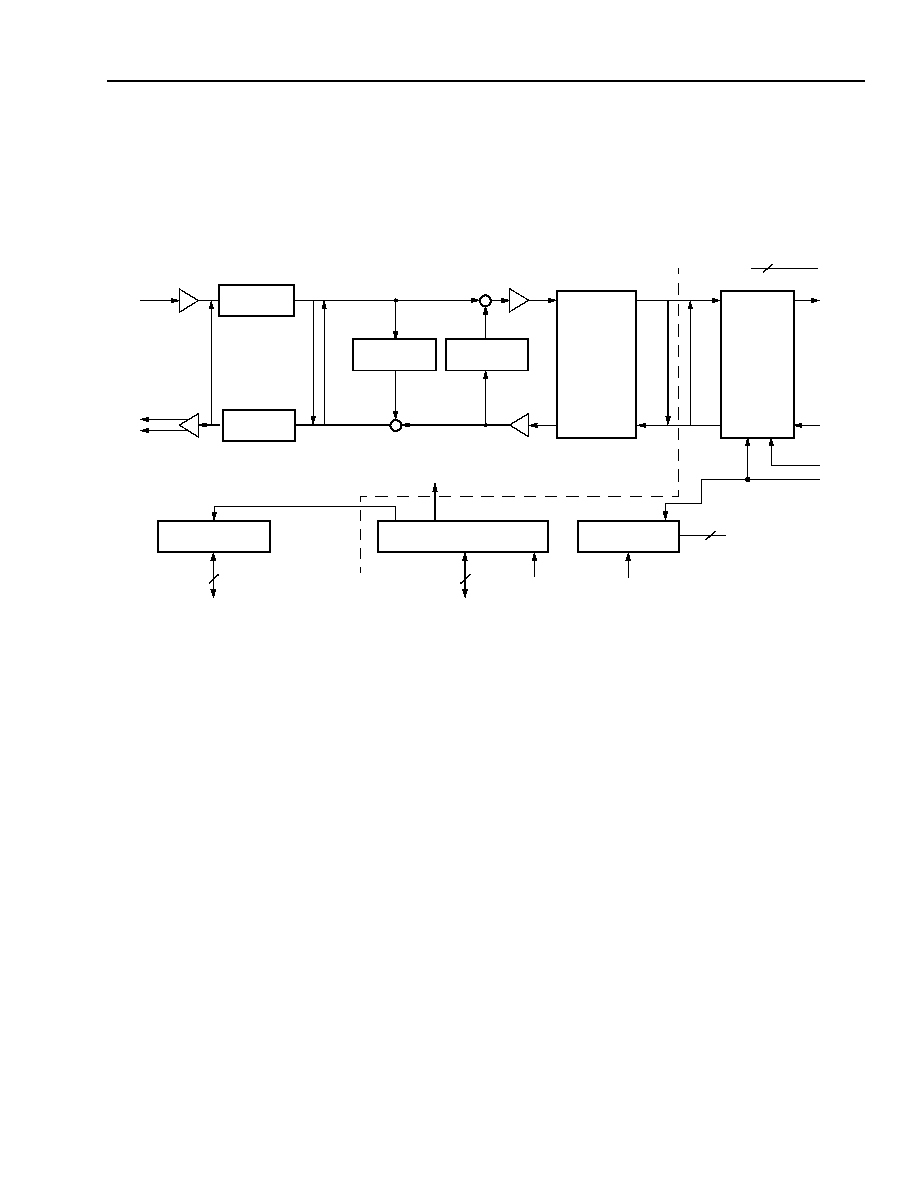
Preliminary Data Sheet
July 2001
Signal Processor
T8533/34 Quad Programmable Line Card
Agere Systems Inc.
3
Functional Description
Refer to Figure 1 for the following discussion. (It should be noted that much of the processing is performed in a dig-
ital processor; thus, the actual data flow may be different than this functional, analog analogy based diagram
shows.)
5-7172.ar5(F)
Figure 1. Functional Block Diagram, Each Section
RST
MCLK
SLIC
TO/FROM
ANALOG
GAIN
A/D
CONVERTER
ANALOG
BUFFER
D/A
CONVERTER
ANAL
O
G
L
O
O
PBA
C
K
DI
GIT
A
L
L
O
O
PBA
C
K
3
DI
GIT
A
L
L
O
O
PBA
C
K
2
TERMINATION
IMPEDANCE
ECHO
CancellER
DIGITAL GAIN
(GAIN TRANSFER)
µ
-LAW
PER
CHANNEL
COMMON
DI
GIT
A
L
L
O
O
PBA
C
K
4
DI
GIT
A
L
L
O
O
PBA
C
K
1
PCM BUS
INTERFACE
DX
DR
TO/FROM
PCM BUS
POWER AND
GROUND
18
FS
BCLK
SLIC
CONTROL LATCHES
MICROPROCESSOR CONTROL
CONTROL AND DATA SIGNALS
4
SERIAL
CONTROL
INTERFACE
PER
CHANNEL
COMMON
0 TO 6
FREQUENCY
SYNTHESIZER
3
FACTORY TEST
OR
CONVERSION
A-LAW
DIGITAL GAIN
(GAIN TRANSFER)
≠
VF
X
INn
VF
R
OPn
VF
R
ONn
This device performs virtually all the signal processing
functions associated with a central office line termina-
tion. Functionality includes line termination impedance
synthesis, adaptive or fixed hybrid balance (echo can-
celler), and level conversion both in the analog sense
(transmit equalization), to accommodate various sub-
scriber line interface circuits (SLICs), and in the digital
sense, for adjustment of the levels on the PCM bus
(gain transfer). In general, the termination impedance
synthesis generates the equivalent of a circuit with the
parallel combination of a capacitor and a resistor in
series with a resistor or the parallel combination of a
resistor and the series combination of a resistor and
capacitor. These general forms of impedance charac-
teristic will satisfy most of the requirements specified
throughout the world. Programmable selection of either
µ
-law or A-law encoding further aids worldwide deploy-
ment. In addition to the programmable features for
impedance and coding, the device also contains an
echo canceller that meets international requirements
for network echo cancellers. This includes the ability to
automatically disable the adaptation in the presence of
2100 Hz modem tones. All coefficients used in the fil-
tering algorithms can be computed off-line in advance
and downloaded to the device at the time of powerup.
All signal processing is contained within the device,
and there are only three interfaces of consequence to
the system designer: the SLIC interface, the PCM inter-
face, and the control interface.

Preliminary Data Sheet
July 2001
Signal Processor
T8533/34 Quad Programmable Line Card
4
Agere Systems Inc.
Functional Description
(continued)
The SLIC interface is designed to be flexible and con-
venient to use with a variety of SLIC circuits. With an
appropriate choice of SLIC, no external components
are required in the interface, with the exception of a dc
blocking capacitor in the transmit direction. In some
cases, dc blocking capacitors in the receive direction
may be necessary as well, since the device operates
from a single 5 V supply.
The PCM bus interface is flexible in that it allows, inde-
pendently, the transmit and receive data for any chan-
nel to be placed in any time slot. The bus can be
operated at a maximum of a 16.384 Mbits/s rate to
accommodate a maximum of 256 time slots. Separate
pins are provided for each direction of transmission to
allow 4-wire bus operation. The frame strobe signal is
an 8 kHz signal that defines the beginning of the frame
structure. The interface will count 8 bits per time slot
and insert or read the data for each channel as pro-
grammed. Lower speeds of the PCM bus are allowed.
The PCM clock must be synchronous with the master
clock for the device (if present) and with the frame
strobe signal.
The microprocessor control interface is a serial inter-
face that uses the classic chip select type of operation.
The interface controls the device by writing or reading
various internal addresses. The command set com-
prises simple read and write operations, with the
address determining the effect. All the memory loca-
tions, including the per-chip functions, are organized by
channel, allowing a straightforward migration path to
architectures other than quad.
There are several test modes included to facilitate
confirmation of correct operation. In the signal path,
both an analog and four digital loopback tests are avail-
able, while in the microprocessor interface, there is a
write/read test mode that tests the operation of the
memory. Use of external test access switches allows a
complete test of the signal path through the line card so
that correct operation of various operational modes can
be verified.

Preliminary Data Sheet
July 2001
Signal Processor
T8533/34 Quad Programmable Line Card
Agere Systems Inc.
5
Pin Information
5-8195(F)
Figure 2. 44-Pin PLCC Pin Diagram
Table 1. Pin Assignments, 44-Pin PLCC, Per-Channel Functions
Ckt
Name
Type
Name/Description
a
b
c
d
15 22 23 30
AGND
GND Analog Ground. A common AGND, DGND, SGND plane is highly recom-
mended.
14 21 24 31
V
DD
PWR 5 V Analog Power Supply.
13 20 25 32
VF
X
I
I
Transmit Analog Input. For complex terminations, this node requires a 10 M
or 20 M
resistance to AGND.
12 19 26 33 VF
R
OP
O
Receive Analog Output, Positive Polarity.
11 18 27 34 VF
R
ON
O
Receive Analog Output, Negative Polarity.
5
4
3
2
1
44
43
42
MCLK
DCLK
DR
RS
T
FI
L
T
V
DO
6
41
40
V
DD
DI
IN
T
S
DG
ND
26
25
24
23
22
21
20
19
27
V
DD
b
VF
X
Ic
VF
R
ON
b
VF
R
OPb
VF
R
ON
c
V
DD
A
G
NDc
28
18
VF
X
Ib
V
DD
c
VF
R
OP
c
A
G
NDb
15
14
13
12
11
10
9
V
DD
a
PVCOIN
PVCO
SGND
DGND
V
DD
VF
R
OPa
16
17
8
7
VF
X
Ia
PLLT
AGNDa
VF
R
ONa
32
34
35
36
38
33
VF
X
Id
DX
DGND
FS
AGNDd
DGND
VF
R
ONd
31
30
29
39
V
DD
VF
R
OPd
BCLK
V
DD
d
37
CS
T8533

Preliminary Data Sheet
July 2001
Signal Processor
T8533/34 Quad Programmable Line Card
6
Agere Systems Inc.
Pin Information
(continued)
Table 2. Pin Assignments, 44-Pin PLCC, Common Functions
Pin
Name
Type
Name/Description
1
DO
O
Serial Data Output. This is a 3-state output.
2
DI
I
Serial Data Input.
3
DCLK
I
Serial Data Clock Input.
4
CS
I
Chip Select Input. This pin determines the interval that the serial interface is
active.
5
INTS
I
Serial Interface Select. Leaving this pin open places the serial interface in
the normal mode; grounding it places the interface into the byte-by-byte
mode. This pin has an internal pull-up.
6
FILTV
PWR
Frequency Synthesizer Power (5 V). This pin must be tied to V
DD
.
7
PVCOIN
--
Internal Test Point. Do not connect to this pin.
8
PVCO
--
Internal Test Point. Do not connect to this pin.
9
PLLT
--
Internal Test Point. Do not connect to this pin.
10
SGND
GND
Synthesizer Ground. Connect to DGND. A common AGND, DGND, SGND
plane is highly recommended.
16, 29, 38, 44
DGND
GND
Digital Ground. Logic ground and return for logic power supply. A common
AGND, DGND, SGND plane is highly recommended.
17, 28, 35, 42
V
DD
PWR
Digital Power Supply (5 V).
36
FS
I
PCM Frame Strobe Input. This 8 kHz clock must be derived from the same
source as BCLK. See the Clocking Considerations section.
37
BCLK
I
PCM Clock Input. This pin is used to develop internal clocks for certain clock
rates. See the Clocking Considerations section.
39
DX
O
PCM Bus Output Pin. This is a 3-state output.
40
DR
I
PCM Bus Input Pin.
41
RST
I
Power-On Reset. A low causes a reset of the entire chip. This pin may be
connected to DGND with a 0.1
µ
F capacitor for a power-on reset function, or
it may be driven by external logic. This pin has an internal pull-up.
43
MCLK
I
1.024 MHz Master Clock Input. Internal timing is derived from this clock
input for certain PCM bus rates. See Clocking Considerations. When unused,
this pin may be left open. This pin has an internal pull-up.

Preliminary Data Sheet
July 2001
Signal Processor
T8533/34 Quad Programmable Line Card
Agere Systems Inc.
7
Pin Information
(continued)
5-8194(F)
Figure 3. 68-Pin PLCC Pin Diagram
Table 3. Pin Assignments, 68-Pin PLCC, Per-Channel Functions
Ckt
Name
Type
Name/Description
a
b
c
d
21 34 35 48
AGND
GND Analog Ground. A common AGND, DGND, SGND plane is highly recom-
mended.
20 33 36 49
V
DD
PWR 5 V Analog Power Supply.
19 32 37 50
VF
X
I
I
Transmit Analog Input. For complex terminations, this node requires a 10 M
or 20 M
resistance to AGND.
18 31 38 51 VF
R
OP
O
Receive Analog Output, Positive Polarity.
17 30 39 52 VF
R
ON
O
Receive Analog Output, Negative Polarity.
16 29 41 53
SLIC0
I/O
SLIC Control Pin 0.
15 27 42 54
SLIC1
I/O
SLIC Control Pin 1.
9
26 43 61
SLIC2
I/O
SLIC Control Pin 2.
8
25 44 63
SLIC3
I/O
SLIC Control Pin 3.
7
23 46 64
SLIC4
I/O
SLIC Control Pin 4.
6
22 47 62
SLIC5
I/O
SLIC Control Pin 5.
6
4 3 2 1 68 67 66 6564
5
MCL
K
DCL
K
SL
IC
2
d
SL
IC
3
d
RS
T
IN
T
S
SL
IC
4
a
SL
IC
2
a
DO
7
8
9
63 6261
V
DD
DI
SL
IC
5
d
SL
IC
4
d
CS
SL
IC
5
a
SL
IC
3
a
DG
ND
40
38
37
36
35
34
33
32
31
30
39
V
DD
b
VF
X
Ic
SL
IC
1b
SL
IC
0b
VF
R
OP
b
VF
R
ON
c
SLI
C
0c
SLI
C
2c
A
G
NDc
41 42 43
29
28
27
VF
X
Ib
V
DD
c
V
DD
VF
R
ON
b
VF
R
OP
c
V
DD
SLI
C
1c
A
G
NDb
23
21
20
19
18
17
16
15
14
13
22
SLIC0a
V
DD
a
FILTV
SGND
SLIC5b
DGND
SLIC2b
VF
R
OPa
24
25
26
12
11
10
SLIC1a
VF
X
Ia
PVCOIN
PLLT
AGNDa
SLIC4b
SLIC3b
VF
R
ONa
47
49
50
51
52
53
54
55
56
57
48
SLIC1d
VF
X
Id
DR
DGND
FS
AGNDd
SLIC4c
SLIC3c
VF
R
ONd
46
45
44
58
59
60
V
DD
VF
R
OPd
DX
BCLK
V
DD
d
SLIC5c
DGND
SLIC0d
T8534
PVCO

Preliminary Data Sheet
July 2001
Signal Processor
T8533/34 Quad Programmable Line Card
8
Agere Systems Inc.
Pin Information
(continued)
Table 4. Pin Assignments, 68-Pin PLCC, Common Functions
Pin
Name
Type
Name/Description
1
DO
O
Serial Data Output. This is a 3-state output.
2
DI
I
Serial Data Input.
3
DCLK
I
Serial Data Clock Input.
4
CS
I
Chip Select Input. This pin determines the interval that the serial interface is
active.
5
INTS
I
Serial Interface Select. Leaving this pin open places the serial interface in
the normal mode; grounding it places the interface into the byte-by-byte
mode. This pin has an internal pull-up.
10
FILTV
PWR
Frequency Synthesizer Power (5 V). This pin must be tied to V
DD
.
11
PVCOIN
--
Internal Test Point. Do not connect to this pin.
12
PVCO
--
Internal Test Point. Do not connect to this pin.
13
PLLT
--
Internal Test Point. Do not connect to this pin.
14
SGND
GND
Synthesizer Ground. Connect to DGND. A common AGND, DGND, SGND
plane is highly recommended.
24, 45, 58, 68
DGND
GND
Digital Ground. Logic ground and return for logic power supply. A common
AGND, DGND, SGND plane is highly recommended.
28, 40, 55, 66
V
DD
PWR
Digital Power Supply (5 V).
56
FS
I
PCM Frame Strobe Input. This 8 kHz clock must be derived from the same
source as BCLK. See the Clocking Considerations section.
57
BCLK
I
PCM Clock Input. This pin is used to develop internal clocks for certain clock
rates. See the Clocking Considerations section.
59 DX
O
PCM Bus Output Pin. This is a 3-state output.
60
DR
I
PCM Bus Input Pin.
65
RST
I
Power-On Reset. A low causes a reset of the entire chip. This pin may be
connected to DGND with a 0.1
µ
F capacitor for a power-on reset function, or
it may be driven by external logic. This pin has an internal pull-up.
67
MCLK
I
1.024 MHz Master Clock Input. Internal timing is derived from this clock
input for certain PCM bus rates. See the Clocking Considerations section.
When unused, this pin may be left open. This pin has an internal pull-up.
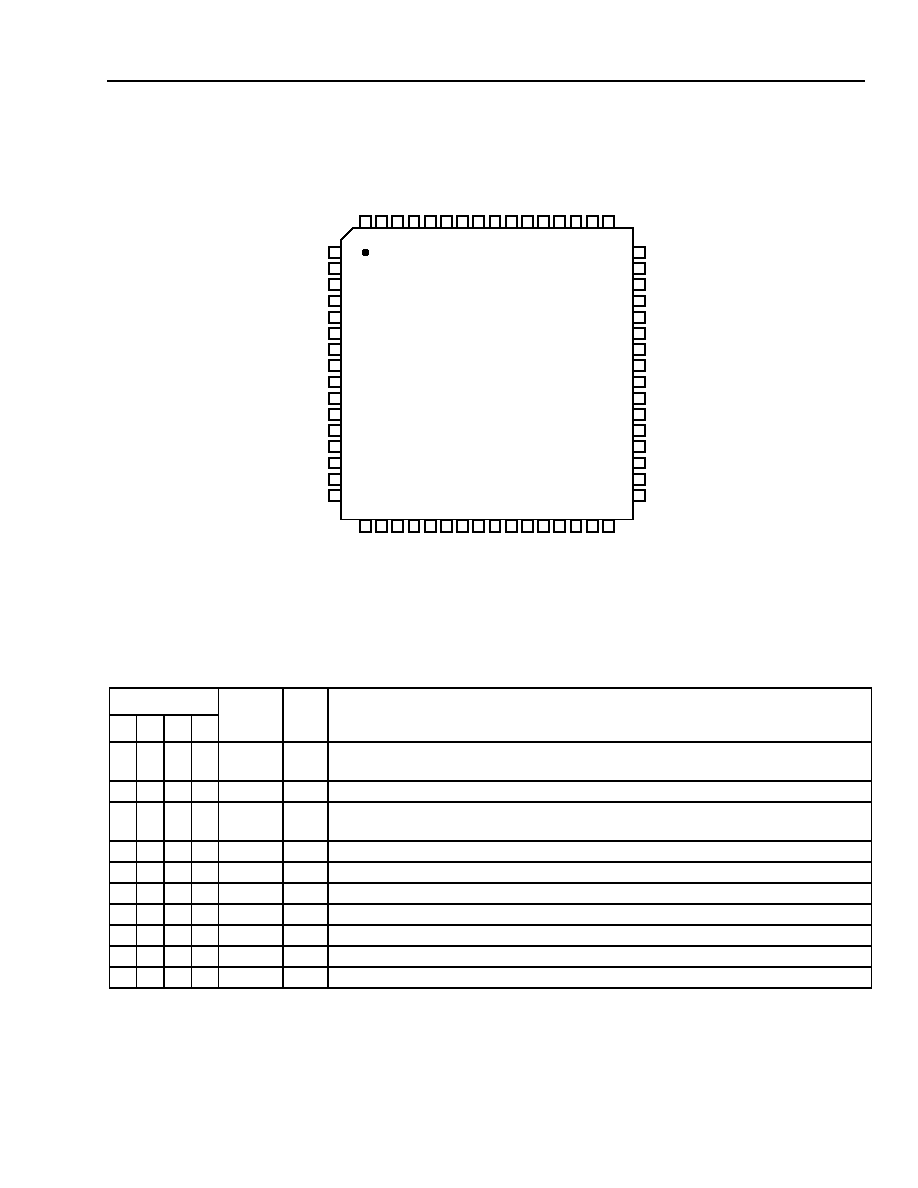
Preliminary Data Sheet
July 2001
Signal Processor
T8533/34 Quad Programmable Line Card
Agere Systems Inc.
9
Pin Information
(continued)
5-8196(F)
Figure 4. 64-Pin TQFP Pin Diagram
Table 5. Pin Assignments, 64-Pin TQFP, Per-Channel Functions
Ckt
Name
Type
Name/Description
a
b
c
d
12 24 25 37
AGND
GND Analog Ground. A common AGND, DGND, SGND plane is highly recom-
mended.
11 23 26 38
V
DD
PWR 5 V Analog Power Supply.
10 22 27 39
VF
X
I
I
Transmit Analog Input. For complex terminations, this node requires a 10 M
or 20 M
resistance to AGND.
9
21 28 40 VF
R
OP
O
Receive Analog Output, Positive Polarity.
8
20 29 41 VF
R
ON
O
Receive Analog Output, Negative Polarity.
7
19 31 42
SLIC0
I/O
SLIC Control Pin 0.
6
17 32 43
SLIC1
I/O
SLIC Control Pin 1.
64 16 33 50
SLIC2
I/O
SLIC Control Pin 2.
63 15 34 51
SLIC3
I/O
SLIC Control Pin 3.
62 13 36 52
SLIC4
I/O
SLIC Control Pin 4.
60 59 58 57 56 55 54 53 52
61
MCL
K
DCL
K
DR
SL
IC
3
d
RS
T
IN
T
S
SL
IC
4
a
SL
IC
2
a
DO
62
63
64
51 50 49
V
DD
DI
SL
IC
2
d
SL
IC
4
d
CS
SL
IC
3
a
DG
ND
30
28
27
26
25
24
23
22
21
20
29
V
DD
b
VF
X
Ic
SL
IC
1b
SL
IC
0b
VF
R
OP
b
VF
R
ON
c
SLI
C
0c
SLI
C
1c
A
G
NDc
31 32
19
18
17
VF
X
Ib
V
DD
c
V
DD
VF
R
ON
b
VF
R
OP
c
V
DD
A
G
NDb
13
12
11
10
9
8
7
6
5
4
SLIC0a
V
DD
a
FILTV
PVCO
SGND
DGND
SLIC2b
VF
R
OPa
14
15
16
3
2
1
SLIC1a
VF
X
Ia
PVCOIN
PLLT
AGNDa
SLIC4b
SLIC3b
VF
R
ONa
36
38
39
40
41
42
43
44
45
46
37
SLIC1d
VF
X
Id
DX
DGND
FS
AGNDd
DGND
SLIC2c
VF
R
ONd
35
34
33
47
48
V
DD
VF
R
OPd
BCLK
V
DD
d
SLIC4c
SLIC3c
SLIC0d
T8534

Preliminary Data Sheet
July 2001
Signal Processor
T8533/34 Quad Programmable Line Card
10
Agere Systems Inc.
Pin Information
(continued)
Table 6. Pin Assignments, 64-Pin TQFP, Common Functions
Pin
Name
Type
Name/Description
1
FILTV
PWR
Frequency Synthesizer Power (5 V). This pin must be tied to V
DD
.
2
PVCOIN
--
Internal Test Point. Do not connect to this pin.
3
PVCO
--
Internal Test Point. Do not connect to this pin.
4
PLLT
--
Internal Test Point. Do not connect to this pin.
5
SGND
GND
Synthesizer Ground. Connect to DGND. A common AGND, DGND, SGND
plane is highly recommended.
14, 35, 47, 56
DGND
GND
Digital Ground. Logic ground and return for logic power supply. A common
AGND, DGND, SGND plane is highly recommended.
18, 30, 44, 54
V
DD
PWR
Digital Power Supply (5 V).
45
FS
I
PCM Frame Strobe Input. This 8 kHz clock must be derived from the same
source as BCLK. See the Clocking Considerations section.
46
BCLK
I
PCM Clock Input. This pin is used to develop internal clocks for certain clock
rates. See the Clocking Considerations section.
48
DX
O
PCM Bus Output Pin. This is a 3-state output.
49
DR
I
PCM Bus Input Pin.
53
RST
I
Power-On Reset. A low causes a reset of the entire chip. This pin may be
connected to DGND with a 0.1
µ
F capacitor for a power-on reset function, or
it may be driven by external logic. This pin has an internal pull-up.
55
MCLK
I
1.024 MHz Master Clock Input. Internal timing is derived from this clock
input for certain PCM bus rates. See the Clocking Considerations section.
When unused, this pin may be left open. This pin has an internal pull-up.
57
DO
O
Serial Data Output. This is a 3-state output.
58
DI
I
Serial Data Input.
59
DCLK
I
Serial Data Clock Input.
60
CS
I
Chip Select Input. This pin determines the interval that the serial interface is
active.
61
INTS
I
Serial Interface Select. Leaving this pin open places the serial interface in
the normal mode; grounding it places the interface into the byte-by-byte
mode. This pin has an internal pull-up.

Agere Systems Inc.
11
Preliminary Data Sheet
July 2001
Signal Processor
T8533/34 Quad Programmable Line Card
Functional Description
Clocking Considerations
This device has several clock inputs for the various
interfaces. The PCM bus uses BCLK as the bit clock
and the one-going edge of FS to determine the location
of the beginning of a frame. These two clocks must be
derived from the same source. Internally, the device
develops all the internal clocks with a phase-locked
loop that uses BCLK as the timing source when BCLK
is 16.384, 8.192, 4.096, 2.048, or 1.024 MHz. In these
instances, MCLK is not used and may be left open
since any signal driving MCLK is ignored. For BCLK
rates of 256 kHz and 512 kHz, MCLK is used as a
source for the PLL and must be 1.024 MHz. In this lat-
ter case, BCLK, MCLK, and FS must be derived from
the same source and the rising edge of BCLK must be
within 10 ns of the rising edge of MCLK. BCLK, FS,
and MCLK (if required) must be continuously present
and without gaps in order for the device to operate cor-
rectly. Note that the nominal values in Table 15 are the
valid frequencies for BCLK.
DCLK is used to clock the internal serial interface and
may be asynchronous to the other clocks. There is no
need to derive this clock from the same source as the
other clocks. The serial bus may be operated at any
speed up to 4.096 Mbits/s. DCLK can be gapped, how-
ever additional clock cycles are required in and around
the command frame to process data, and during and
after a hardware or a software reset to ensure com-
plete clearing of internal logic. There is no limit on the
number of devices on the same serial bus.
The Control Interface
The device is controlled via a series of memory loca-
tions accessed by a serial data connection to the exter-
nal master controller. This interface operates using the
chip select lead to enable transmission of information.
All chip functions are enabled or disabled by setting or
clearing bits in the control memory. Filter coefficients
and gain adjustments are also stored in this memory.
The codec has both a serial input lead and a serial out-
put lead. These may be used individually for a 4-wire
serial interface, or tied together for a 2-wire interface.
The line driver circuitry is capable of driving relatively
high currents so that in the event that the line is long
enough to show significant transmission line effects, it
can be terminated in the characteristic impedance at
each end with resistors to V
CC
and ground.
All data transfers on the serial bus are byte oriented
with the least significant bit (shown in this data sheet as
bit 0) transmitted first, followed by the more significant
bits. For data fields, the least significant byte of the first
data byte is transmitted first, followed by the more sig-
nificant bytes, each byte transmitted LSB first. This for-
mat is compatible with the serial port on most
microcontrollers.
Modes
There are two different modes of operation for the
serial interface, the normal mode and the byte-by-byte
mode. These two modes differ in the manner in which
CS is used to control the transfer. Note that the CS
lead is used to control the transfer of serial data from
master controller to slave codec and in the reverse
direction.
In normal mode, (INTS pin open) the CS lead must go
low for the duration of the transfer. The only error check
performed by the codec is to verify that CS is low for an
integral number of bytes. Detection of an active (active-
low) chip select for other than an integral multiple of 8
bits results in the operation being terminated. The next
active excursion of chip select will be interpreted as a
new command; hence, the serial I/O interface can
always be initialized by asserting CS for a number of
clock periods that is not an integral multiple of 8. CS is
captured using DCLK, so DCLK must be transitioned to
perform this initialization. Undefined command codes
are reserved for future use and may cause unwanted
operation of the device.
The byte-by-byte mode (INTS pin tied to ground) uses
CS to control each byte of the transfer. In this mode,
CS goes low for exactly 8 bits at a time, corresponding
to a 1-byte transfer either to or from the codec chip.
Repeated transitions of CS are used to control subse-
quent bytes of data to/from the codec. For a write com-
mand in this mode, CS must go low for each byte of the
transfer until the transfer is complete. For a read com-
mand, CS will go low for each of the 3 bytes of the read
command transferred to the device, then low again for
each byte to be read. Notice that the total number of
bytes transferred (and excursions on CS) is N + 3,
where N is the number of bytes to be read in the com-
mand. This mode of operation is useful in cases where
the master is a microprocessor with a built-in UART
that transfers 1 byte at a time. Error detection is limited
to detection of an active CS for other than an integral
multiple of 8 bits. Recovery is the same as normal
mode. Note that the clock phase is shifted in this mode.
Flow control can be accomplished by suspending the
transitions on DCLK by holding either state. During the
data transfer, CS must remain low while clock transi-
tions are suspended with DCLK in either state.

12
12
Agere Systems Inc.
Preliminary Data Sheet
July 2001
Signal Processor
T8533/34 Quad Programmable Line Card
Functional Description
(continued)
The Control Interface
(continued)
Protocol
The format of the command protocol is shown in Fig-
ures 5 and 6.
The control interface operates with one external master
controller and multiple slave codec devices. Each
transfer is initiated by the master, and the slave
responds for either read operations or the fast scan
mode. The slave does not check the bus for activity
prior to transmitting; it only checks for an active CS.
The master should allow for a wait between the end of
a read command until CS becomes active for the read
data. The master must refrain from sending additional
commands to the slave chip until the response is
received. On a 4-wire bus, commands to other devices
may be initiated before the response is received, but
care in generating the CS function is needed to ensure
that the multiple responses do not interfere. It should
be noted that multiple memory locations can be
accessed in the same command by setting the data
field length field to the desired number of bytes to be
transferred. If flow control is desired, it must be per-
formed by using separate commands, each transfer-
ring smaller blocks of information, or by controlling the
serial clock (gapping the serial clock), or with CS in the
case of byte-by-byte mode.
There is no response from the slave to the master for a
write operation. The response to a read operation sim-
ply includes the data to be read in the data field. This
data is sent least significant bit first, with the bytes sent
in ascending sequence. Commands from the master
controller include data for write operations, but not for
read operations. Since the coefficients and gains are
stored in volatile memory, all the coefficients and gains
must be loaded after powerup. There is, however, no
need to reload them when switching from active to
standby modes, or vice versa. Great care should be
exercised in loading memory when the codec channel
is not in standby mode. Sudden changes in the termi-
nation or balance impedances can result in undesirable
system operation.
All data is transmitted in a byte-oriented fashion with
the least significant bit of each byte transferred first.
Multibyte fields are transferred least significant byte
first in both directions. The data field will contain the
first addressed data location first, with subsequent data
locations transmitted in ascending order.
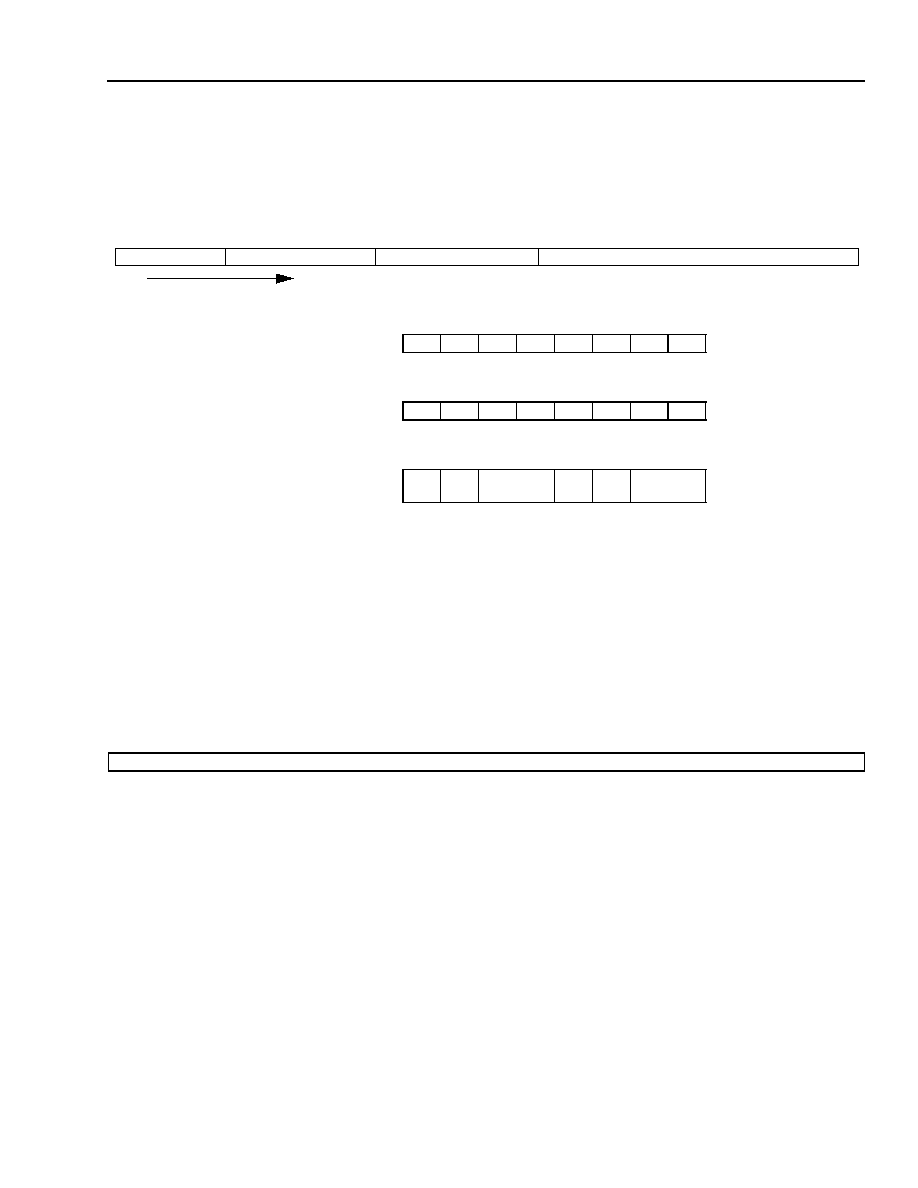
Preliminary Data Sheet
July 2001
Signal Processor
T8533/34 Quad Programmable Line Card
Agere Systems Inc.
13
Functional Description
(continued)
The Control Interface
(continued)
Protocol (continued)
* Location of memory bank selection. All user controls are in memory bank 0; other memory banks contain internal state information for the
device.
Note: Data field length is in bytes for all operations. All data is transmitted in bytes with the LSB for each byte transmitted first. For 16-bit mem-
ory operations, the least significant byte of the first memory location is transmitted first, followed by the most significant byte; each byte is
transmitted LSB first. Additional memory locations are loaded in ascending sequence.
Figure 5. Command Frame Format, Master to Slave, Read or Write Commands
Note: All data is transmitted in bytes with the LSB for each byte transmitted first. For memory operations, the least significant byte of the first
memory location is transmitted first, followed by the most significant byte, each byte transmitted LSB first. Additional memory locations
are loaded in ascending sequence.
Figure 6. Command Frame Format, Slave to Master, Read Commands
LSB
MSB LSB
MSB LSB
MSB LSB
COMMAND (8 bits)
START ADDRESS (8 bits)
DATA FIELD LENGTH (8 bits)
DATA FIELD (VARIABLE LENGTH) WRITE OPERATIONS ONLY
TIME
7
6
5
4
3
2
1
0
MSB
LSB
START ADDRESS:
7
6
5
4
3
2
1
0
MSB
LSB
DATA FIELD LENGTH:
7
6
5
4
3
2
1
0
MSB
LSB
COMMAND:
0*
0*
CKT
SELECT
0
0
COMMAND
CKT SELECT:
CKT a:
CKT b:
CKT c:
CKT d:
00
01
10
11
COMMANDS: FAST SCAN MODE:
WRITE MEMORY:
WRITE ALL CHANNELS:
READ MEMORY:
10
01
11
00
LSB
DATA FIELD (VARIABLE LENGTH) READ OPERATIONS ONLY
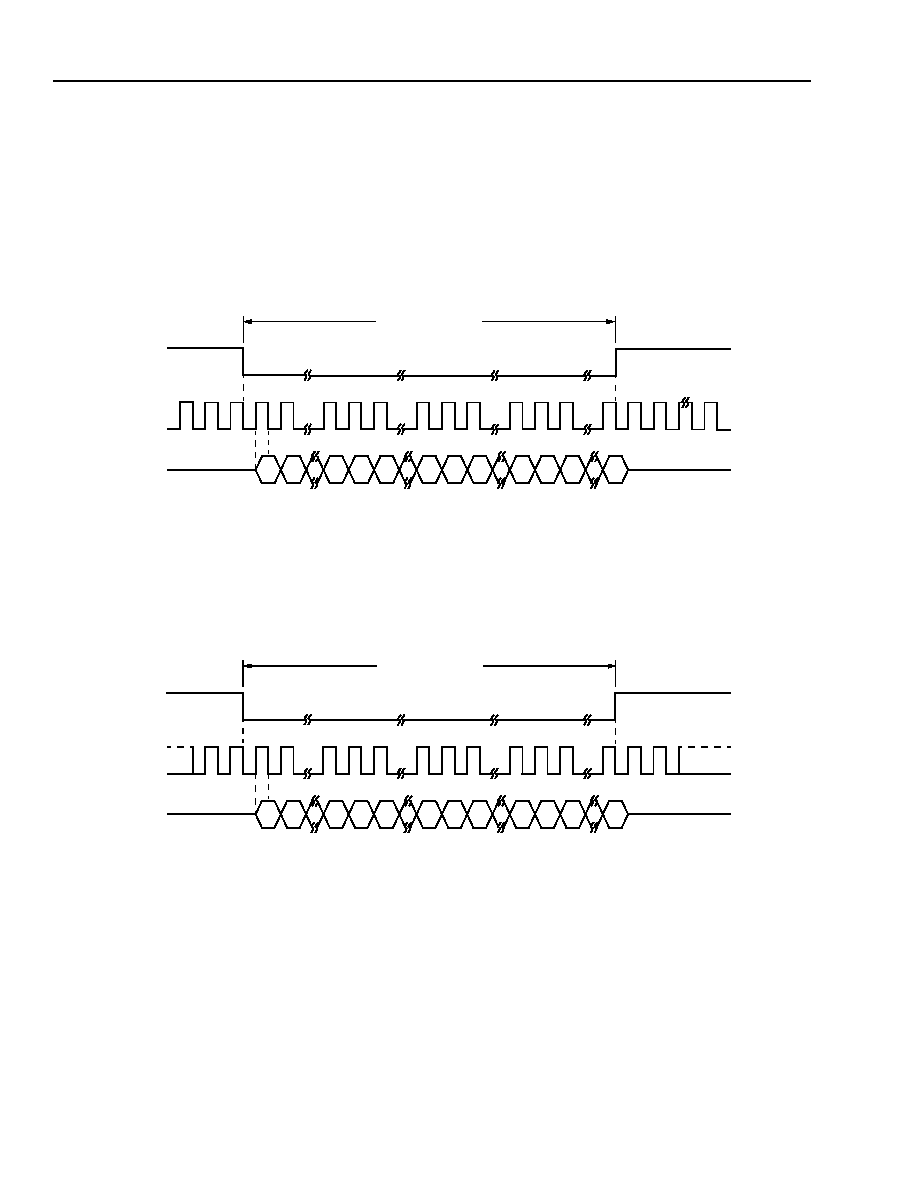
Preliminary Data Sheet
July 2001
Signal Processor
T8533/34 Quad Programmable Line Card
14
Agere Systems Inc.
Functional Description
(continued)
The Control Interface
(continued)
Write Command
A write command is used to write to the memory addresses. Figures 7--10 illustrate normal or byte-by-byte opera-
tion with continuous or gapped DCLKs. For gapped DCLK operation, transitions, not frequency, are critical (as long
as transitions occur no faster than 122 ns apart).
0078
* Two or more full DCLK cycles are required before the start of a new command frame.
Note: Data field length of 1 shown.
Figure 7. Write Operation, Normal Mode (Continuous DCLK)
0076
Notes:
Data field length of 1 shown.
CK1 through CK4 are additional DCLK pulses required to properly process the data.
CK3 and CK4 are not necessary if another command frame follows this sequence.
Figure 8. Write Operation, Normal Mode (Gapped DCLK)
COMMAND FRAME
0
1
7
0
1
7
CS
DCLK
DI
COMMAND
START ADDRESS
DATA
0
1
7
0
1
7
0
1
7
0
1
7
LENGTH
0
1
7
0
1
7
*
COMMAND FRAME
0
1
7
0
1
7
CS
DCLK
DI
COMMAND
START ADDRESS
DATA
0
1
7
0
1
7
0
1
7
0
1
7
CK1
CK2
CK3
CK4
LENGTH
0
1
7
0
1
7
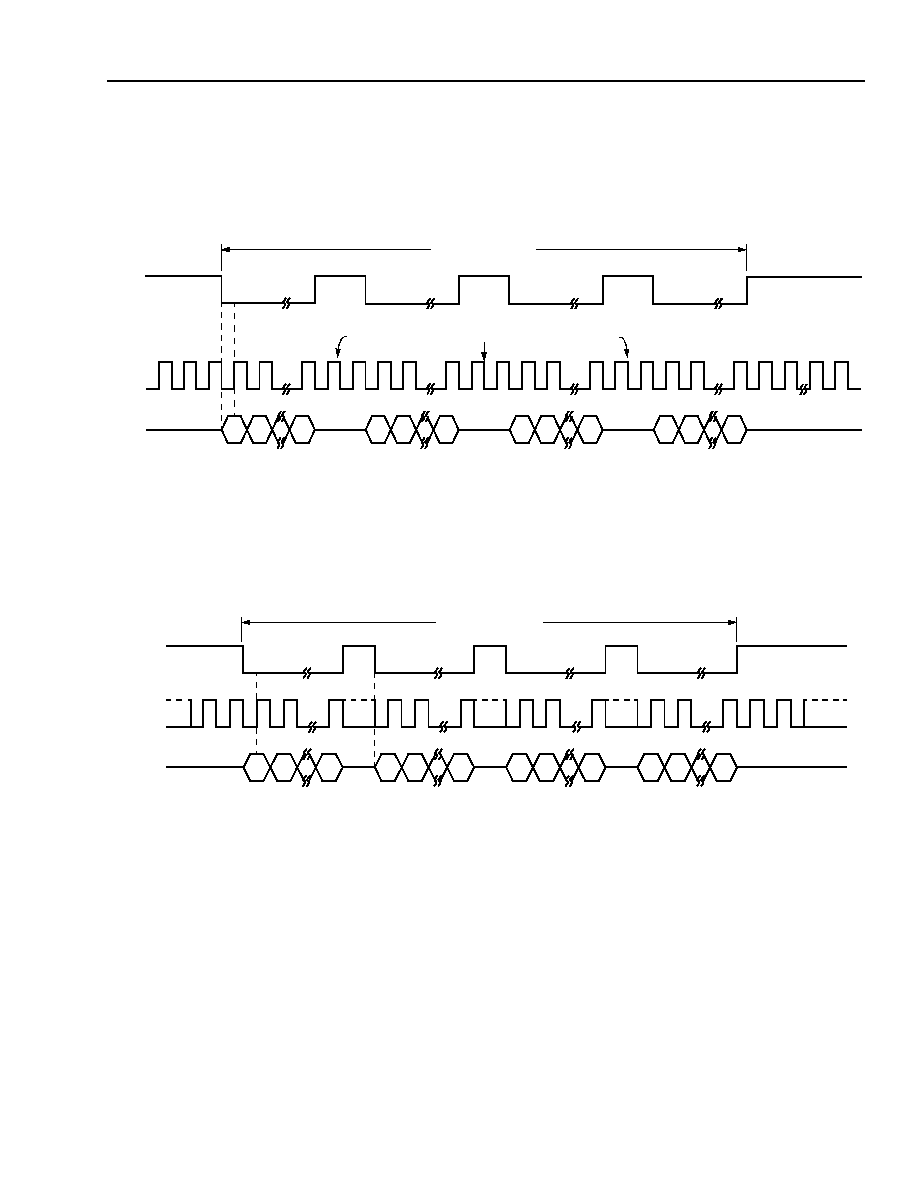
Preliminary Data Sheet
July 2001
Signal Processor
T8533/34 Quad Programmable Line Card
Agere Systems Inc.
15
Functional Description
(continued)
The Control Interface
(continued)
Write Command (continued)
0074
* Two or more full DCLK cycles are required before the start of a new command frame.
Note: Data field length of 1 shown.
Figure 9. Write Operation, Byte-by-Byte Mode (Continuous DCLK)
0072
Notes:
Data field length of 1 shown.
CK1 through CK4 are additional DCLK pulses required to properly process the data.
CK3 and CK4 are not necessary if another command frame follows this sequence.
Figure 10. Write Operation, Byte-by-Byte Mode (Gapped DCLK)
0
1
7
0
1
7
CS
DCLK
DI
COMMAND
START ADDRESS
LENGTH
DATA
0
1
7
0
1
7
0
1
7
0
1
7
0
1
7
0
1
7
COMMAND FRAME
ONE OR MORE FULL DCLK CYCLES REQUIRED HERE
*
CK1
CK2
0
1
7
0
1
7
CS
DCLK
DI
COMMAND
START ADDRESS
LENGTH
DATA
COMMAND FRAME
0
1
7
0
1
7
0
1
7
0
1
7
CK3
CK4
0
1
7
0
1
7
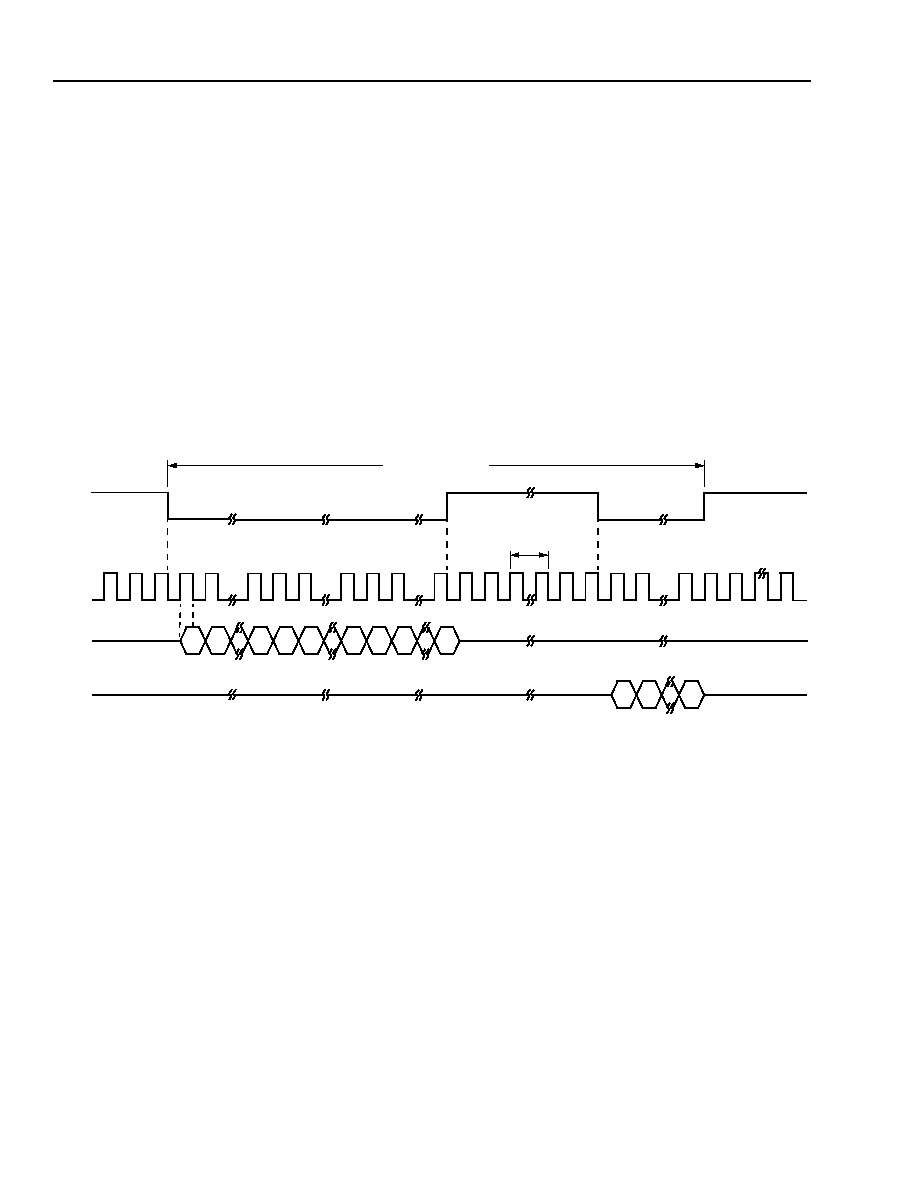
Preliminary Data Sheet
July 2001
Signal Processor
T8533/34 Quad Programmable Line Card
16
Agere Systems Inc.
Functional Description
(continued)
The Control Interface
(continued)
Read Command
The normal flow of information to the master controller is always in response to a read command. All control mem-
ory locations are accessed in 8-bit bytes. All read commands from the master controller require a response from
the addressed codec. It is the responsibility of the master controller to ensure that only one device is transmitting
on the serial interface line at any one time. The master controller also must ensure that the CS lead goes high after
transferring the 3-byte sequence used to initiate the read, and then it goes low again for the response. In this case,
it should be noted that the device expects the second time CS goes low that data is to be sent to the master; thus,
it does not interpret the DI lead as containing a valid instruction during that CS excursion and a write during this
time is not recommended. Note also that the CS lead must allow the number of bytes sent in a read command to
be transferred before a subsequent command can be received by the codec. Figures 11--14 illustrate normal or
byte-by-byte operation with continuous or gapped DCLKs. Like a write command, transitions, not frequency, are
critical with regard to gapped DCLK operation.
0079
* Provide sufficient wait time to access read data. Provide sufficient DCLK cycles to effectively wait
1.5
µ
s after the second full DCLK cycle
and before the second to last full DCLK cycle. DCLK operation of 4.096 MHz would require 10 cycles of DCLK between LENGTH and DATA.
The first two DCLK cycles, when CS goes high, processes the command. A wait is then required to access the read data. Two final DCLK
cycles are required to process the read data.
Two or more DCLK cycles are required before the start of a new command frame.
Note: Data field length of 1 shown.
Figure 11. Read Operation, Normal Mode (Continuous DCLK)
COMMAND FRAME
0
1
7
0
1
7
CS
DCLK
DI
COMMAND
START ADDRESS
DATA
0
1
7
0
1
7
0
1
7
LENGTH
0
1
7
0
1
7
0
1
7
DO
WAIT
1.5
µ
s
*

Preliminary Data Sheet
July 2001
Signal Processor
T8533/34 Quad Programmable Line Card
Agere Systems Inc.
17
Functional Description
(continued)
The Control Interface
(continued)
Read Command (continued)
0077
Notes:
Data field length of 1 shown.
CK1 through CK8 are additional DCLK pulses required to properly process the data.
CK7 and CK8 are not necessary if another command frame follows this sequence.
Figure 12. Read Operation, Normal Mode (Gapped Clock)
COMMAND FRAME
0
1
7
0
1
7
CS
DCLK
DI
COMMAND
START ADDRESS
DATA
0
1
7
0
1
7
0
1
7
CK1
CK2
CK7
CK8
LENGTH
0
1
7
0
1
7
0
1
7
CK5
CK6
CK3
CK4
DO
WAIT
1.5
µ
s
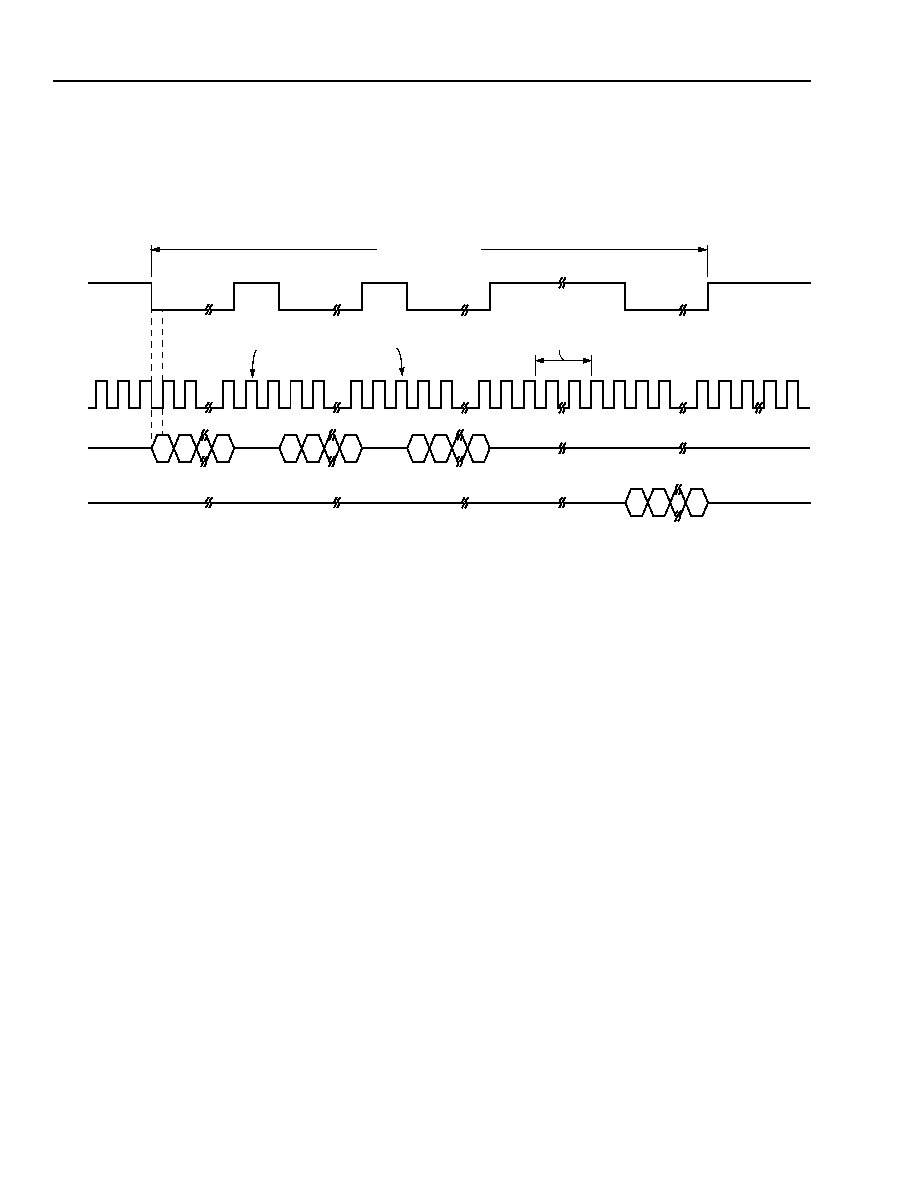
Preliminary Data Sheet
July 2001
Signal Processor
T8533/34 Quad Programmable Line Card
18
Agere Systems Inc.
Functional Description
(continued)
The Control Interface
(continued)
Read Command (continued)
0075
* Provide sufficient wait time to access read data. Provide sufficient DCLK cycles to effectively wait
1.5
µ
s after the second full DCLK cycle
and before the second to last full DCLK cycle. DCLK operation of 4.096 MHz would require 10 cycles of DCLK between LENGTH and DATA.
The first two DCLK cycles, when CS goes high, processes the command. A wait is then required to access the read data. Two final DCLK
cycles are required to process the read data.
Two or more DCLK cycles are required before the start of a new command frame.
Note: Data field length of 1 shown.
Figure 13. Read Operation, Byte-by-Byte Mode (Continuous DCLK)
0
1
7
0
1
7
CS
DCLK
DI
COMMAND
START
LENGTH
DATA
0
1
7
0
1
7
0
1
7
0
1
7
0
1
7
*
COMMAND FRAME
ONE OR MORE FULL DCLK
D0
0
1
7
CYCLES REQUIRED HERE
WAIT
1.5
µ
s
ADDRESS
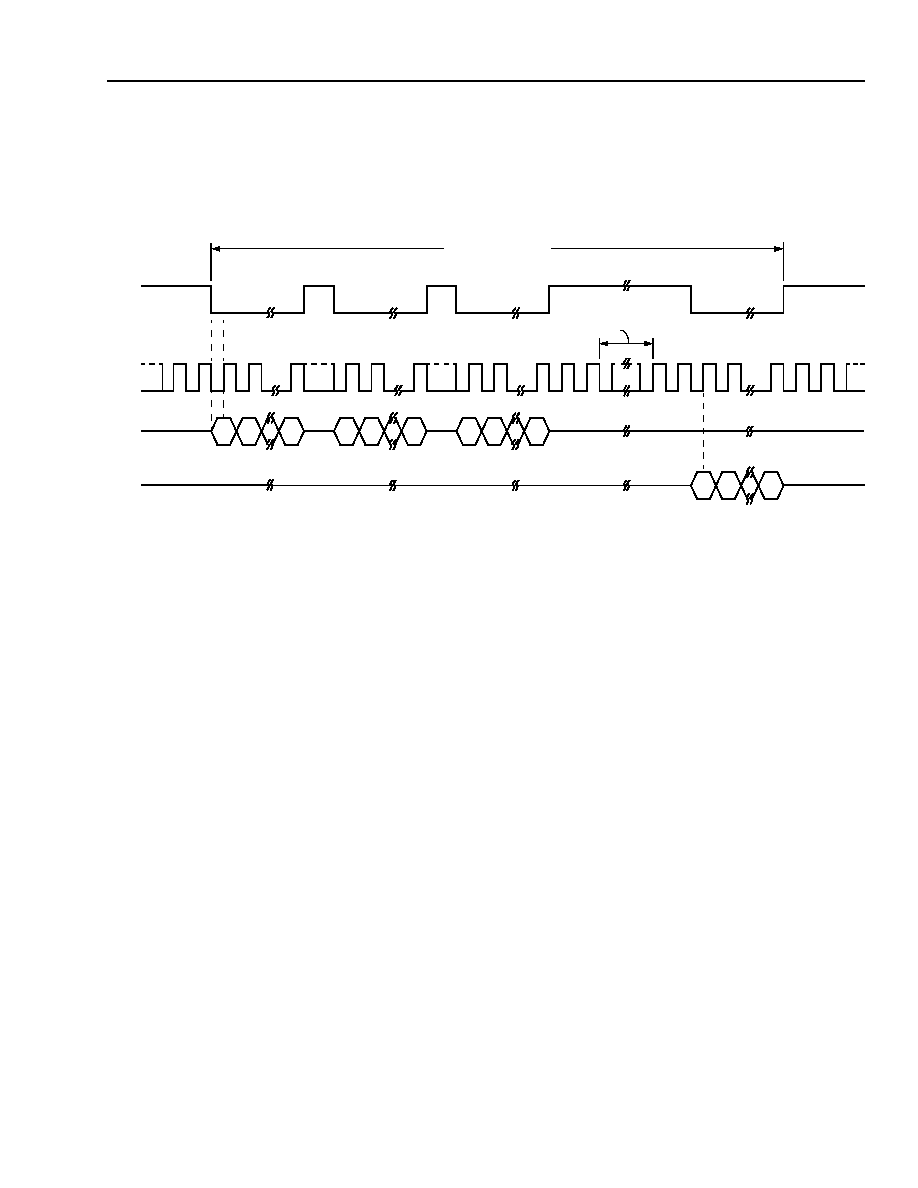
Preliminary Data Sheet
July 2001
Signal Processor
T8533/34 Quad Programmable Line Card
Agere Systems Inc.
19
Functional Description
(continued)
The Control Interface
(continued)
Read Command (continued)
0073
Notes:
Data field length of 1 shown.
CK1 through CK8 are additional DCLK pulses required to properly process the data.
CK7 and CK8 are not necessary if another command frame follows this sequence.
Figure 14. Read Operation, Byte-by-Byte Mode (Gapped DCLK)
0
1
7
CK
3
CK4
CK
5
CK6
DATA
CK1
CK2
0
1
7
0
1
7
COMMAND
START
LENGTH
CS
DCLK
DI
D0
COMMAND FRAME
0
1
7
CK
7
CK8
0
1
7
0
1
7
0
1
7
0
1
7
WAIT
1.5
µ
s
ADDRESS

Preliminary Data Sheet
July 2001
Signal Processor
T8533/34 Quad Programmable Line Card
20
Agere Systems Inc.
Functional Description
(continued)
The Control Interface
(continued)
Fast Scan Mode
The fast scan mode allows a single byte command to read two SLIC control leads for all four channels with a
1-byte reply. This mode significantly speeds up the normal scanning for off-hook, ring trip, and ring ground detec-
tion. This special command sequence allows the controlling microprocessor to fast scan 2 bits in the SLIC control
byte of each of the four channels. The command code is (00000010)
2
, there are no start address or length fields.
The command returns only a single byte of data, formatted as shown in Table 9.
Table 7. Bit Assignments for Fast Scan Mode
The circuit select in the command structure (Figure 5) is not used for this special single-byte command. The rules
for toggling chip select apply as for the read command. Figures 15--18 illustrate normal or byte-by-byte operation
with continuous or gapped DCLKs.
0125
* Provide sufficient wait time to access read data. Provide sufficient DCLK cycles to effectively wait
1.5
µ
s after the second full DCLK cycle
and before the second to last full DCLK cycle. DCLK operation of 4.096 MHz would require 10 cycles of DCLK between COMMAND and
DATA. The first two DCLK cycles, when CS goes high, processes the command. A wait is then required to access the read data. Two final
DCLK cycles are required to process the read data.
Two or more DCLK cycles are required before the start of a new command frame.
Figure 15. Fast Scan, Normal Mode (Continuous DCLK)
Bit
Reported Status
0 (LSB)
Channel 0, bit 0 (ckt a, address 160, bit 0)
1
Channel 0, bit 1 (ckt a, address 160, bit 1)
2
Channel 1, bit 0 (ckt b, address 160, bit 0)
3
Channel 1, bit 1 (ckt b, address 160, bit 1)
4
Channel 2, bit 0 (ckt c, address 160, bit 0)
5
Channel 2, bit 1 (ckt c, address 160, bit 1)
6
Channel 3, bit 0 (ckt d, address 160, bit 0)
7 (MSB)
Channel 3, bit 1 (ckt d, address 160, bit 1)
1
2
3
CS
DCLK
DI
COMMAND
DATA
4
5
DO
WAIT
1.5
µ
s
0
1
2
3
4
5
6
7
6
7
0
1
2
3
4
5
6
7
0
*

Preliminary Data Sheet
July 2001
Signal Processor
T8533/34 Quad Programmable Line Card
Agere Systems Inc.
21
Functional Description
(continued)
The Control Interface
(continued)
Fast Scan Mode (continued)
0127
Note: CK1 through CK8 are additional DCLK pulses required to properly process the data.
Figure 16. Fast Scan, Normal Mode (Gapped DCLK)
1
2
3
CS
DCLK
DI
COMMAND
DATA
4
5
DO
WAIT
1.5
µ
s
0
1
2
3
4
5
6
7
6
7
0
1
2
3
4
5
6
7
0
CK7
CK8
CK0
CK1
CK3
CK4
CK5
CK6
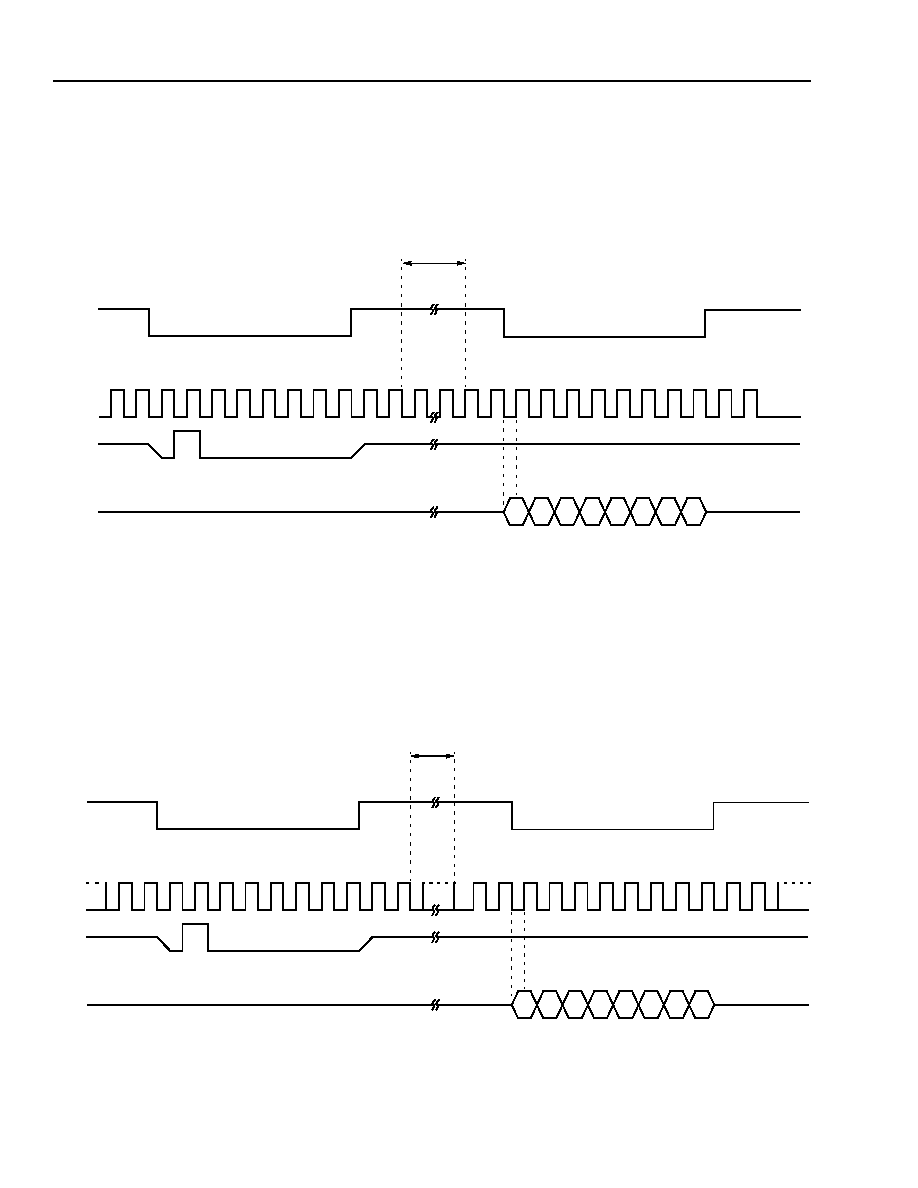
Preliminary Data Sheet
July 2001
Signal Processor
T8533/34 Quad Programmable Line Card
22
Agere Systems Inc.
Functional Description
(continued)
The Control Interface
(continued)
Fast Scan Mode (continued)
0124e
* Provide sufficient wait time to access read data. Provide sufficient DCLK cycles to effectively wait
1.5
µ
s after the second full DCLK cycle
and before the second to last full DCLK cycle. DCLK operation of 4.096 MHz would require 10 cycles of DCLK between COMMAND and
DATA. The first two DCLK cycles, when CS goes high, processes the command. A wait is then required to access the read data. Two final
DCLK cycles are required to process the read data.
Two or more DCLK cycles are required before the start of a new command frame.
Figure 17. Fast Scan, Byte-by-Byte Mode (Continuous DCLK)
0126f
Note: CK1 through CK8 are additional DCLK pulses required to properly process the data.
Figure 18. Fast Scan, Byte-by-Byte Mode (Gapped DCLK)
1
2
3
CS
DCLK
DI
COMMAND
DATA
4
5
DO
WAIT
1.5
µ
s
0
1
2
3
4
5
6
7
6
7
0
1
2
3
4
5
6
7
0
*
1
2
3
CS
DCLK
DI
COMMAND
DATA
4
5
DO
WAIT
1.5
µ
s
0
1
2
3
4
5
6
7
6
7
0
1
2
3
4
5
6
7
0
CK7
CK8
CK0
CK1
CK3
CK4
CK5
CK6
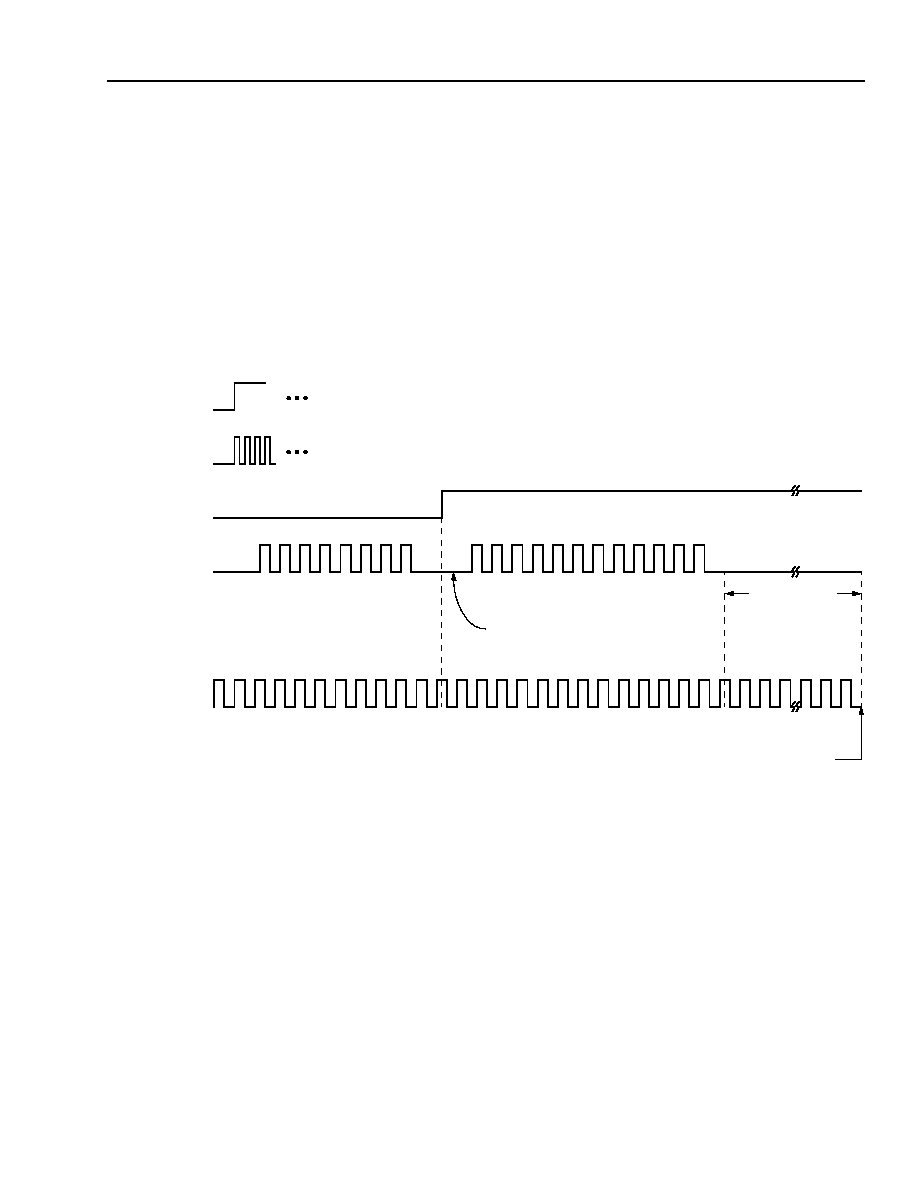
Preliminary Data Sheet
July 2001
Signal Processor
T8533/34 Quad Programmable Line Card
Agere Systems Inc.
23
Functional Description
(continued)
The Control Interface
(continued)
Write All Channels
The write all channels command causes all four channels to be loaded with the same coefficients with a single data
transfer from the master controller. This allows for a faster initialization of the device after a powerup. This com-
mand should be used with caution since it affects all four channels. The normal memory write and read commands
affect only one channel.
Reset Functionality
0071
Figure 19. Hardware Reset Procedure
The reset function allows the internal logic of the device to be set to a known initial condition, either externally by
activating the reset lead, or on a per-channel basis through the microprocessor interface by setting and then
clearing bits, if required, in address RESCTRL (address 128). These two reset functions have different effects, and
each of the software reset functions is a subset of the hardware reset functionality. The primary difference is in
the treatment of the internal memory. The hardware reset is assumed to be a result of a catastrophic hardware
event, such as a loss of power or an initial powerup. Accordingly, the assumption is made that the internal memory
does not contain valid data, and default values for all memory locations are loaded. A software reset, however, can
only be initiated if the device is operational (at least the microprocessor interface), so the contents of the memory
may indeed be valid; thus, the resets may be more specific. Additionally, software resets only affect the selected
channel.
FS
BCLK
RST
DCLK
(GAPPED)
DCLK
(CONTINUOUS)
8 PULSES REQUIRED
DURING RESET
12 PULSES REQUIRED
AFTER RESET
NO GAP IS REQUIRED HERE.
8 PULSES REQUIRED
DURING RESET
12 PULSES REQUIRED
AFTER RESET
DEVICE
CAN NOW BE PROGRAMMED
WAIT
5 ms
RUNS CONTINUOUSLY
RUNS CONTINUOUSLY

24
24
Agere Systems Inc.
Preliminary Data Sheet
July 2001
Signal Processor
T8533/34 Quad Programmable Line Card
Functional Description
(continued)
Reset Functionality
(continued)
A 0.1
µ
F capacitor between the RST lead and ground
will effectively hold the lead low long enough to reset
the device on powerup, allowing for a cost-effective
power-on reset function. Notice that the memory must
be reloaded through the serial interface after a hard-
ware reset function. For proper operation, it is neces-
sary for FS and BCLK to be present and stable during
a reset. DCLK transitions (frequency is not critical as
long as the maximum rate is not exceeded) are also
required in order for all internal logic to be properly
cleared as is a wait period for the internal PLL to stabi-
lize. See the timing diagram shown in Figure 19 for the
proper hardware or power-on reset procedure.
For a software reset, the control memory should not be
accessed for a minimum of 256
µ
s following the reset.
Memory Control Mapping
Several memory locations are used to control the
device. The Software Interface tables (Table 17, Mem-
ory Mapping and Table 18, Control Bit Definition) show
the memory assignments that are useful in call pro-
cessing and system testing. It should be noted that
other memory locations are used by the device to hold
intermediate results and other device state information.
Writing to these other locations can cause serious dis-
ruptions in the operation of the device and should be
avoided.
Standby Mode
The device enters a low-power standby mode with
powerup or software reset, or by programming the
CHACTIVE register 129, bit 0. In standby mode, the
control interface is active, capable of writing or reading
registers. SLIC read and write data latches are also
active. Analog signals at VF
X
I and PCM signals at D
R
are ignored in this mode. BCLK must be present for
proper standby mode operation.
Test Capabilities
The device has several built-in test capabilities that can
be used to verify correct operation of the signal pro-
cessing of the line card. These test functions are
accessed in several different control addresses. Five
loopback modes are employed (the first four in the list
below are digital loopbacks):
Digital 1.
Allows the digital signal from the PCM bus
to be looped back to the PCM bus. This
loopback facility can be used to verify cor-
rect operation of the PCM bus interface
logic, as well as operation of the PCM
bus.
Digital 2.
Allows complete testing of the digital pro-
cessing capability of the codec by looping
the data back at the analog/digital conver-
sion interface.
Digital 3.
This loopback function is at the digital side
of the sigma-delta mode converters and
loops analog transmit data back to the
analog receive path.
Digital 4.
This loopback is at the PCM bus interface
and loops the transmit data from the line
back to the receive path.
Analog 5.
The analog loopback facility can be used
to check the operation of all the signal
processing performed in the device,
including the conversions to/from analog.
Three of these loopback functions (digital 1 and 2, and
the analog loopback) can be used with tone generation
and reception via the PCM bus.
By assigning the transmit and receive time slots identi-
cally, a loopback arrangement at the PCM bus can be
effectively programmed for signals generated on the
line side of the codec. This mode is useful for testing
from the line side through the entire device.
An optional 16-bit encoding mode is included on a per-
channel basis for use in various test scenarios, or for
use by an external digital signal processor. This mode
of operation differs from the companded modes in both
the bit order and the use of multiple time slots on the
PCM bus.

Agere Systems Inc.
25
Preliminary Data Sheet
July 2001
Signal Processor
T8533/34 Quad Programmable Line Card
Functional Description
(continued)
Echo Canceller Functionality
The echo canceller has three sets of coefficient mem-
ory storage locations. One, called HPRE, contains the
default balance coefficients and can be accessed as
memory addresses 0--127. This serves as the coeffi-
cients for a fixed balance network (adaptation dis-
abled), or as a starting point for echo cancelllation. The
contents of these memory locations do not change with
adaptation. The adaptation coefficients, which are
added to the corresponding coefficients in HPRE, are
stored in the HHAT area. Normally, the user has no
need to access these coefficients; thus, these
addresses are not described in this data sheet. The
HHAT coefficients cover either the first 8, 16, 32, or the
entire 64-tap length of the balance filter, depending on
the settings in the LMSGAIN address. Note that all
echo canceller length options in this control location
may not be implemented, but are reserved for future
use.
A third set of coefficients is contained in HDTA, which
are used for special data call functions.
SLIC Control Capabilities
Memory locations 158, 159, and 160 are used to con-
trol six bidirectional latches that are intended to allow
the serial interface to control other line card devices,
such as ringing/test switches, telecom electromechani-
cal relays, and SLIC devices. When the TTL latches
are configured as outputs, external devices should be
set up to sink current from the latch. Location 158 sets
the operational mode of these latches as either inputs
or outputs. Location 159 specifies what is to be written
on the latch leads driven by the device. Location 160
reports the actual state of these leads. It should be
noted that a channel control reset forces all of these
external leads, except those corresponding to bits 2
and 3, to the high-impedance state, so any inputs con-
nected to bits 0, 1, 4, and 5 should have appropriate
pull-up or pull-down resistors (off-chip, if required) to
force the external device into a known state at power-
up or in the event of a reset. Bits 2 and 3 will reset to
outputs with a value of zero.
The fast scan mode allows for a minimal data transfer
on the serial bus to monitor bits 0 and 1 of the SLIC
data memory location (159). If these 2 bits are wired as
inputs to the off-hook and/or ring ground detection cir-
cuits, a convenient method of rapidly scanning for
these two functions is obtained. Bits 2 and 3 default to
outputs; thus, they are convenient to provide control of
the SLIC state. In any event, all six leads are program-
mable for maximum flexibility.
Suggested Initialization Procedures
It is suggested that upon powerup, a hardware reset be
used to set the device into a known state. The serial
interface should then be used to load the memory
addresses that differ from the default values (the write
all channels command is convenient for this function).
If other devices are controlled by the SLIC data mem-
ory location, then it also should be loaded with a known
configuration. After the completion of this sequence,
the device is ready to be activated. Depending on the
application, the next step may either be normal opera-
tion or a set of test sequences. After the initialization of
the memory, the device and associated line card
devices can be controlled by using memory locations
130, 131, 145, 155, 156, 157, 158, 159, and 129; that
is, by supplying the PCM bus time-slot addresses,
switching the SLIC into the proper mode, and activating
the codec. Within memory location 129, the codec
would normally be placed into active mode, with both
directions of the PCM bus enabled at the start of a call.
At the completion of a call, the codec should be placed
into standby mode and the PCM bus disabled. Great
caution should be used when changing the memory
while the codec is in active mode, since termination
impedances, balance impedances, and gains may
change. These changes are likely to yield undesirable
system effects. It is safe to refresh coefficients that are
known to be unchanging in the application. It is always
possible to read the memory to verify its contents with-
out deleterious effects on codec operation. Normal
operation would load the memory and perform all gain
adjustments while the codec is in standby mode. Under
no circumstances should memory above address 162
be written, since this section of memory is used for
state data and intermediate results. Also, all reserved
addresses should not be written. Changing this infor-
mation may have deleterious effects on system opera-
tion.

Preliminary Data Sheet
July 2001
Signal Processor
T8533/34 Quad Programmable Line Card
26
Agere Systems Inc.
Functional Description
(continued)
Signal Processing
Figure 20 details the signal processing functional blocks of one channel of the codec.
0496 F
* Programmable blocks.
Figure 20. Internal Signal Processing
Absolute Maximum Ratings
Stresses in excess of the absolute maximum ratings can cause permanent damage to the device. These are abso-
lute stress ratings only. Functional operation of the device is not implied at these or any other conditions in excess
of those given in the operational section of the data sheet. Exposure to absolute maximum ratings for extended
periods can adversely affect device reliability.
Parameter
Symbol
Min Max
Unit
Storage Temperature Range
T
stg
-
55
150
∞C
Power Supply Voltage (all pins designated power)
V
DDX
--
7
V
Negative Voltage on Any Pin with Respect to Ground
V
SS
-
0.25
--
V
Thermal Resistance, Junction to Case (68-pin PLCC)
R
JC
--
43
∞C/W
Package Power Dissipation (68-pin PLCC)
P
D
--
930
mW
Thermal Resistance, Junction to Case (64-pin MQFP)
R
JC
--
35
∞C/W
Package Power Dissipation (64-pin MQFP)
P
D
--
1.14
W
Thermal Resistance, Junction to Case (44-pin PLCC)
R
JC
--
49
∞C/W
Package Power Dissipation (44-pin PLCC)
P
D
--
815
mW
SPEED
FROM
PCM
BUS
*
GRX1
GAIN
8 kHz
COMP
TO LIN.
TRANSFER
XLPF
GAIN
TWEAKING
GRX2
SINC
3
-
D/A
1-bit
D/A
RCF
SMF
TO
0 dB
ECHO
32 kHz
4096 kHz
LPF
*
DIGITAL
*
*
SLIC
TO
PCM
BUS
*
GAIN
GTX2
LIN.TO
COMP
YLPF
*
GAIN
TWEAKING
GTX1
SINC
3
*
FROM
0 dB TO 24 dB
SLIC
TRANSFER
TEQ
-
A/D
LPF
*
RTZ
8 STEPS
IN 5 STEPS
XAG
ANALOG
CTZ
*
CANCELLER
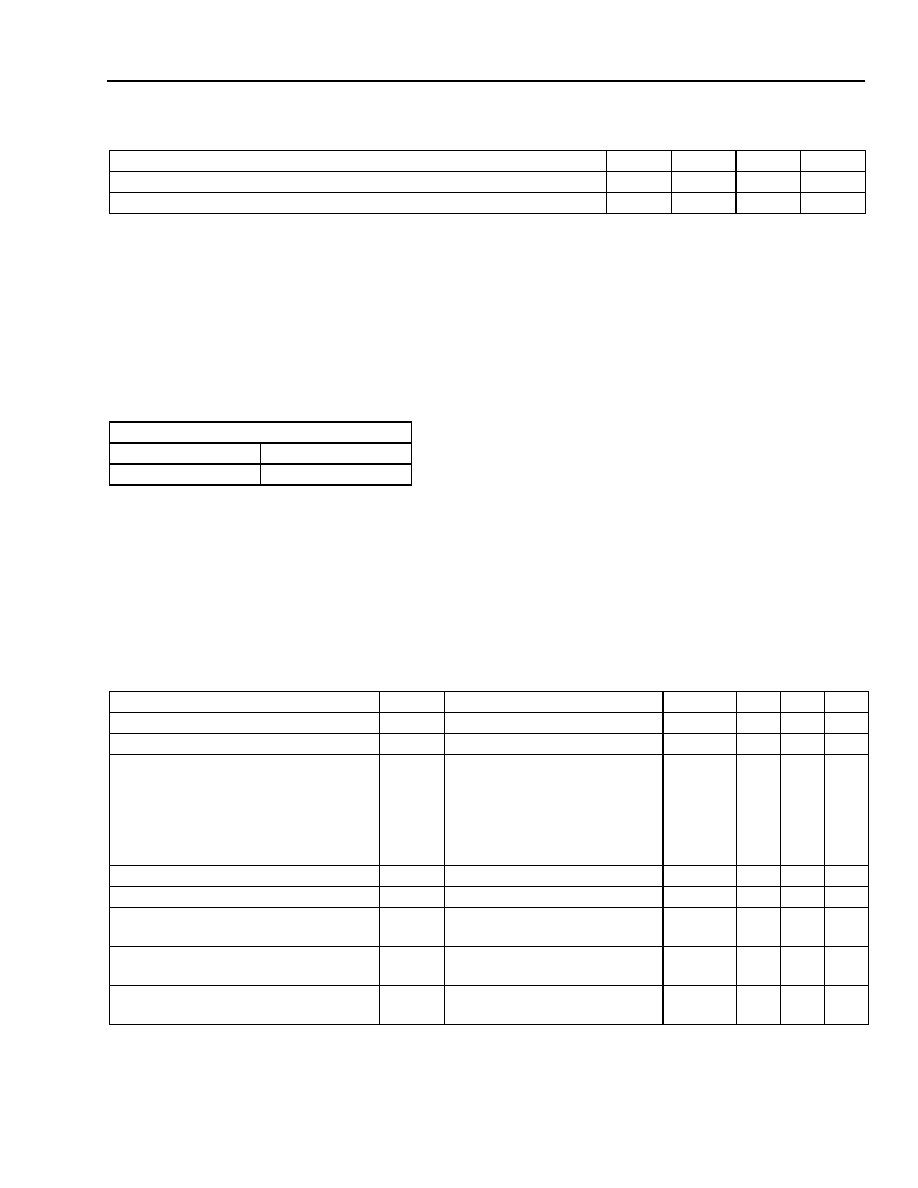
Preliminary Data Sheet
July 2001
Signal Processor
T8533/34 Quad Programmable Line Card
Agere Systems Inc.
27
Operating Ranges
Handling Precautions
Although protection circuitry has been designed into this device, proper precautions should be taken to avoid expo-
sure to electrostatic discharge (ESD) during handling and mounting. Agere Systems Inc. employs a human-body
model (HBM) and a charged-device model (CDM) for ESD susceptibility testing and protection design evaluation.
ESD voltage thresholds are dependent on the circuit parameters used to define the model. No industry-wide stan-
dard has been adopted for the CDM. A standard HBM (resistance = 1500
, capacitance = 100 pF) is widely
accepted and can be used for comparison. The HBM ESD threshold of >1000 V was obtained by using these cir-
cuit parameters:
Electrical Characteristics
For all specifications: T
A
=
-
40 ∞C to +85 ∞C, V
DD
= 5 V ± 5%, unless otherwise noted. Typical values are for
T
A
= 25 ∞C and V
DD
= 5 V. Input signal frequency is 1004 Hz, unless otherwise noted.
dc Characteristics
Table 8. dc Characteristics
Parameter
Symbol
Min Max
Unit
Ambient Operating Temperature
T
A
-
40
85
∞C
Operating Junction Temperature
T
J
-
40
125
∞C
HBM ESD Threshold Voltage
Device
Voltage
T8533/T8534
>2000
Parameter
Symbol
Test Conditions
Min
Typ
Max
Unit
Input Voltage Low
V
IL
All inputs
--
--
0.8
V
Input Voltage High
V
IH
All inputs
2.0
--
--
V
Input Current
I
IL
Digital, without pull-up, inputs,
GND < V
IN
< V
DD
With internal pull-up, V
IN
= GND
(INTS, MCLK, and RST pins)
With internal pull-up, V
IN
= V
DD
(INTS, MCLK, and RST pins)
-
10
-
240
-
10
--
--
--
10
10
10
µ
A
µ
A
µ
A
Output Voltage Low
V
OL
I
L
= 3.2 mA
--
--
0.4
V
Output Voltage High
V
OH
I
L
=
-
320
µ
A
3.5
--
--
V
Output Current in High-impedance
State
I
OZ
GND < V
OUT
< V
DD
-
30
--
30
µ
A
Line Driver (DX and DO pins) Output
Voltage High
V
OH
I
L
=
-
10 mA
V
DD
-
0.5
--
--
V
Line Driver (DX and DO pins) Output
Voltage Low
V
OL
I
L
= 10 mA
--
--
0.5
V
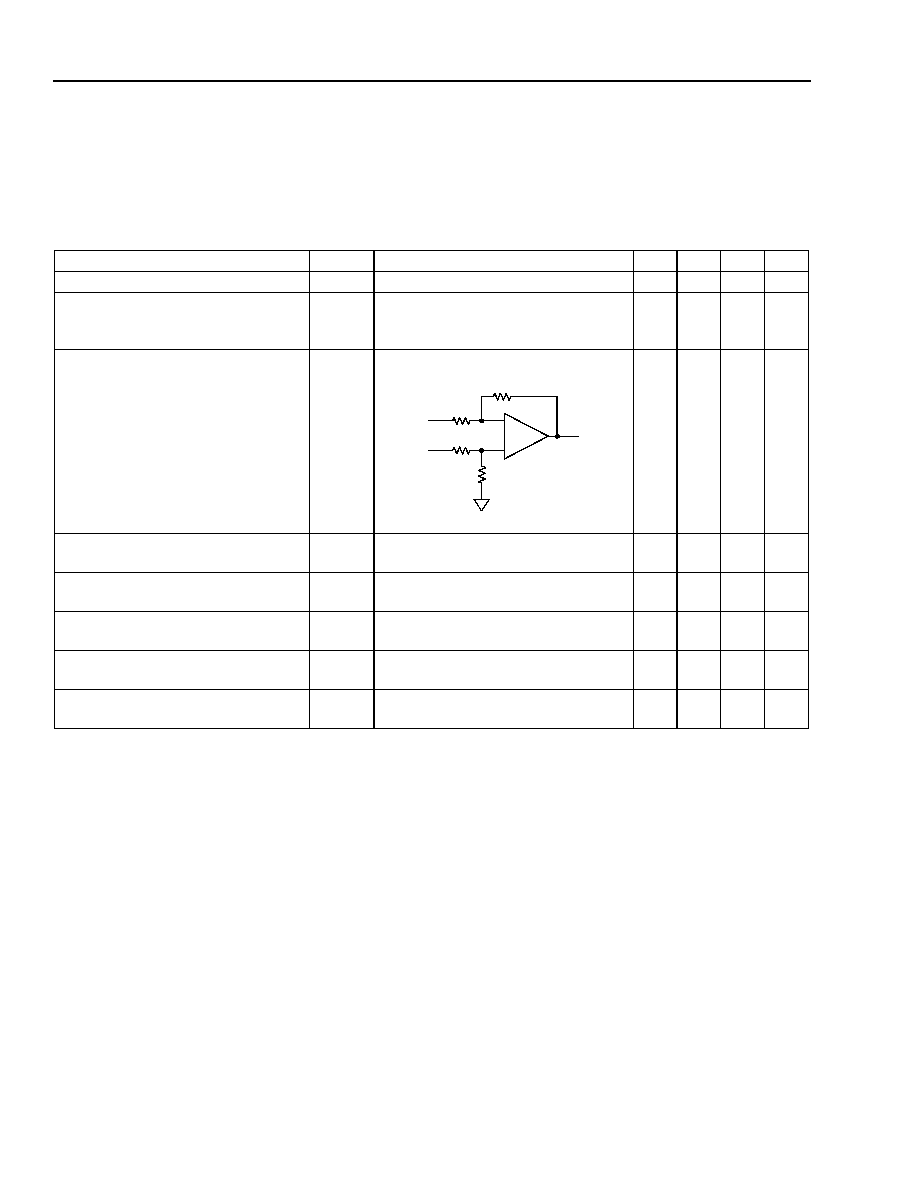
Preliminary Data Sheet
July 2001
Signal Processor
T8533/34 Quad Programmable Line Card
28
Agere Systems Inc.
Electrical Characteristics
(continued)
Analog Interface
The following specifications pertain to the analog SLIC interface for each channel.
Table 9. Analog Interface
Parameter
Symbol
Test Conditions
Min
Typ
Max
Unit
Input Resistance
R
VF
X
I
0.25 < V
IN
< (V
DDX
-
0.25) V
100
--
300
k
Input Voltage
V
IX
Relative to ground
Signal should be capacitively
coupled to VF
X
I
1.8
2.0
2.2
V
Load Resistance at VF
R
OP and
VF
R
ON (differential)
R
L
5-8881F
7.5
--
--
k
Output Resistance
R
O
Digital input code corresponding to
idle PCM code (
µ
-law)
--
2
10
Output Offset Voltage Between
VF
R
OP and VF
R
ON
V
OS
Digital input code corresponding to
idle PCM code (
µ
-law)
-
100
0
100
mV
Output Offset Voltage Between
VF
R
OP and VF
R
ON, Standby Mode
V
OSS
R
L
= 100 k
-
20
0
20
mV
Common-mode Output Voltage,
Active Mode
V
OCM
Digital input code corresponding to
alternating ± zero
µ
-law PCM code
--
2.0
--
V
Common-mode Output Voltage,
Standby Mode
V
OCMS
--
1.7
2.0
2.3
V
R
L
R
L
R
L
R
L

Preliminary Data Sheet
July 2001
Signal Processor
T8533/34 Quad Programmable Line Card
Agere Systems Inc.
29
Electrical Characteristics
(continued)
Analog Interface
(continued)
Table 10. Power Requirements
Transmission Characteristics
Table 11. Transmission Characteristics
Parameter
Min
Typ
Max
Unit
Operating Voltage:
V
DD
V
DDX
4.75
4.75
--
--
5.25
5.25
V
V
Power Supply Current, V
DD
+ V
DDX
:
All Channels in Standby Mode
All Channels Active
--
--
--
--
35
110
mA
mA
Parameter
Symbol
Test Conditions
Min
Typ
Max
Unit
Absolute Levels
GAL
Maximum 0 dBm0 levels (1004 Hz):
VF
X
I (encoder milliwatt), all program-
mable transmit gains set to 0 dB
--
2.80
--
Vp-p
RCV (decoder milliwatt), termination
impedance off, all programmable
receive gains set to 0 dB
--
5.29
--
Vp-p
Minimum 0 dBm0 levels (1004 Hz):
VF
X
I (encoder milliwatt)
XAG = 24 dB
GTX1 = 6 dB
GTX2 = 0 dB
--
87.5
--
mVp-p
RCV (decoder milliwatt), termination
impedance off
GRX1 = 0 dB
GRX2 =
-
6 dB
--
2.63
--
Vp-p
Absolute Maximum Volt-
age Swings
GAL
VF
X
I
VF
R
OP to VF
R
ON (differential)
--
--
--
--
3.2
5.28
Vp-p
Vp-p
Transmit Gain Absolute
Accuracy
GXA
Transmit gain programmed for maxi-
mum 0 dBm0 test level, measured
deviation of digital code from ideal
0 dBm0 level at DX digital outputs,
with transmit gain set to 0 dB:
20 ∞C to 70 ∞C
0 ∞C to 85 ∞C
-
40 ∞C to +85 ∞C
--
-
0.25
-
0.35
±0.15
--
--
--
0.25
0.35
dB
dB
dB
Transmit Gain Variation
with Programmed Gain
GXAG
Measured transmit gain over the
range from maximum to minimum,
calculated deviation from the pro-
grammed gain relative to GXA at
0 dB, V
DD
= 5 V
-
0.1
--
0.1
dB

Preliminary Data Sheet
July 2001
Signal Processor
T8533/34 Quad Programmable Line Card
30
Agere Systems Inc.
Electrical Characteristics
(continued)
Transmission Characteristics
(continued)
Table 11. Transmission Characteristics (continued)
* Applied to all four channels.
Parameter
Symbol
Test Conditions
Min
Typ
Max
Unit
Transmit Gain Varia-
tion with Fre-
quency, 600
Resistive Source
Impedance and
Synthesized Termi-
nation Impedance
GXAF
Relative to 1004 Hz, minimum
gain < GX < maximum gain, VF
X
I = 0 dBm0
signal, path gain set to 0 dB:
f = 16.67 Hz
f = 40 Hz
f = 50 Hz
f = 60 Hz
f = 200 Hz
f = 300 Hz to 3000 Hz
f = 3140 Hz
f = 3380 Hz
f = 3860 Hz
f = 4600 Hz and above
--
--
--
--
--
-
0.125
-
0.57
-
0.735
--
--
-
50
-
40
-
40
-
55
-
3.5
±0.04
0.01
-
0.03
-
9.0
--
-
30
-
26
-
30
-
30
0
0.135
0.125
0.015
-
8.98
-
32
dB
dB
dB
dB
dB
dB
dB
dB
dB
dB
Transmit Gain Varia-
tion with Signal
Level
GXAL
Sinusoidal test method*,
reference level = 0 dBm0:
VF
X
I =
-
40 dBm0 to +3 dBm0
VF
X
I =
-
50 dBm0 to
-
40 dBm0
VF
X
I =
-
55 dBm0 to
-
50 dBm0
-
0.25
-
0.50
-
1.40
--
--
--
0.25
0.50
1.40
dB
dB
dB
Receive Gain Abso-
lute Accuracy
GRA
Receive gain programmed to
-
6 dB, apply
0 dBm0 signal to DR, measure V
RCV
,
R
L
= 100 k
differential:
20 ∞C to 70 ∞C
0 ∞C to 85 ∞C
-
40 ∞C to +85 ∞C
--
-
0.25
-
0.30
±0.15
--
--
--
0.25
0.30
dB
dB
dB
Relative Gain,
VF
R
OP to VF
R
ON
--
Digital input 0 dBm0 signal,
f = 300 Hz to 3400 Hz
-
0.01
--
0.01
dB
Relative Phase,
VF
R
OP to VF
R
ON
--
Digital input 0 dBm0 signal,
f = 300 Hz to 3400 Hz
-
0.25
--
0.25
Degrees
Receive Gain Varia-
tion with Pro-
grammed Gain
GRAG
Measure receive gain over the range from
maximum to minimum setting, calculated
deviation from the programmed gain rela-
tive to GRA at 0 dB, V
DD
= 5 V
-
0.1
--
-
0.1
dB
Receive Gain Varia-
tion with Fre-
quency, 600
Resistive Termina-
tion
GRAF
Relative to 1004 Hz, digital input =
0 dBm0 code, minimum gain < GR < maxi-
mum gain, 0 dB path gain:
f = below 3000 Hz
f = 3140 Hz
f = 3380 Hz
f = 3860 Hz
f = 4600 Hz and above
-
0.125
-
0.57
-
0.735
--
--
±0.04
±0.04
-
0.550
-
10.7
--
0.125
0.125
0.015
-
8.98
-
28
dB
dB
dB
dB
dB
Receive Gain Varia-
tion with Signal
Level
GRAL
Sinusoidal test method*,
reference level = 0 dBm0:
IPCM digital level =
-
40 dBm0 to +3 dBm0
IPCM digital level =
-
50 dBm0 to
-
40 dBm0
IPCM digital level =
-
55 dBm0 to
-
50 dBm0
-
0.25
-
0.50
-
1.40
--
--
--
0.25
0.50
1.40
dB
dB
dB

Preliminary Data Sheet
July 2001
Signal Processor
T8533/34 Quad Programmable Line Card
Agere Systems Inc.
31
Electrical Characteristics
(continued)
Noise Characteristics
Table 12. Per-Channel Noise Characteristics
* RTZ and CTZ paths open. All channels active.
Parameter
Symbol
Test Conditions
Min
Typ
Max
Unit
Transmit Noise,
C-Message Weighted
N
XC
0 dB transmit gain*
--
--
18
dBrnC0
Transmit Noise,
P-Message Weighted
N
XP
0 dB transmit gain*
--
--
-
68
dBm0p
Receive Noise,
C-Message Weighted
N
RC
0 dB receive gain, digital pattern
corresponding to idle PCM code,
µ
-law
--
--
13
dBrnC0
Receive Noise,
P-Message Weighted
N
RP
0 dB receive gain, digital pattern
corresponding to idle PCM code, A-law
--
--
-
75
dBm0p
Noise, Single Frequency
N
RS
f = 0 kHz to 100 kHz, loop around
measurement, V
VFxI
= 0 Vrms
--
--
-
53
dBm0
Power Supply Rejection,
Transmit
PSR
X
V
DD
= 5.0 V
DC
+ 100 mVrms
f = 0 kHz to 4 kHz
f = 4 kHz to 50 kHz
C-message weighted
36
30
--
--
--
--
dBC
dBC
Power Supply Rejection,
Receive
PSR
R
Measured on VF
R
OP,
V
DD
= 5.0 V
DC
+ 100 mVrms:
f = 0 kHz to 4 kHz
f = 4 kHz to 25 kHz
f = 25 kHz to 50 kHz
36
40
36
--
--
--
--
--
--
dBC
dBC
dBC
Spurious Out-of-Band Sig-
nals at the Channel Out-
puts
SOS
0 dBm0, 300 Hz to 3400 Hz signal applied
to V
VFxI
, transmit gain set to 0 dB:
4600 Hz to 7600 Hz
7600 Hz to 8400 Hz
8.4 kHz to 50 kHz
--
--
--
--
--
--
-
30
-
40
-
30
dB
dB
dB

Preliminary Data Sheet
July 2001
Signal Processor
T8533/34 Quad Programmable Line Card
32
Agere Systems Inc.
Electrical Characteristics
(continued)
Distortion and Group Delay
Table 13. Distortion and Group Delay
* Absolute group delay is a function of time-slot assignment, and the maximum in this table refers to the (optimal minimum group delay) time-
slot assignment.
Parameter
Symbol
Test Conditions
Min
Typ
Max
Unit
Signal to Total Distortion,
Transmit or Receive,
C-Message Weighted
STD
X
STD
R
Sinusoidal test method level:
3.0 dBm0
0 dBm0
33
36
--
--
--
--
dB
dB
Single Frequency Distortion,
Transmit
SFD
X
0 dBm0 single frequency input,
200 Hz < f
IN
< 3400 Hz; measured
at any other single frequency
--
--
-
46
dB
Single Frequency Distortion,
Receive
SFD
R
0 dBm0 single frequency input,
200 Hz < f
IN
< 3400 Hz; measured
at any other single frequency
--
--
-
46
dB
Intermodulation Distortion
IMD
Transmit or receive, two
frequencies in the range of
300 Hz to 3400 Hz
--
--
-
50
dB
TX Group Delay, Absolute*
D
XA
f = 1600 Hz, 600
resistive termination
--
--
370
µ
s
RX Group Delay, Absolute*
D
RX
f = 1600 Hz, 600
resistive termination
--
--
220
µ
s

Preliminary Data Sheet
July 2001
Signal Processor
T8533/34 Quad Programmable Line Card
Agere Systems Inc.
33
Electrical Characteristics
(continued)
Crosstalk
Table 14. Crosstalk
Parameter
Symbol
Test Conditions
Min
Typ
Max
Unit
Transmit to Transmit Crosstalk,
0 dBm0 Level
CT
X-X
f = 300 Hz to 3400 Hz,
any channel to any channel
--
--
-
80
dB
Transmit to Receive Crosstalk,
0 dBm0 Level
CT
X-R
f = 300 Hz to 3400 Hz,
any channel to any other channel
In-channel
--
--
--
--
-
80
-
50
dB
dB
Receive to Transmit Crosstalk,
0 dBm0 Level
CT
R-X
f = 300 Hz to 3400 Hz,
any channel to any other channel
In-channel
--
--
--
--
-
80
-
50
dB
dB
Receive to Receive Crosstalk,
0 dBm0 Level
CT
R-R
f = 300 Hz to 3400 Hz,
any channel to any channel
--
--
-
80
dB

Preliminary Data Sheet
July 2001
Signal Processor
T8533/34 Quad Programmable Line Card
34
Agere Systems Inc.
Timing Characteristics
Table 15. Timing Characteristics
* PCM clock (BCLK) must be synchronous with both FS and MCLK, if used. If MCLK is used, then the rising edge of MCLK must coincide with
the rising edge of BCLK within 10 ns.
The t
SXBDLY
delay is from either DCLK or CS, whichever transition is later, for the first bit of the byte.
Symbol
Parameter
Test Conditions
Min
Typ
Max
Unit
f
DCLK
Serial Bus Clock Frequency
--
--
--
4096
kHz
f
BCLK
Allowable PCM Bus Clock Fre-
quencies* (512 kHz minimum
if linear encoding is selected.)
--
--
--
--
--
--
--
--
256
512
1024
2048
4096
8192
16384
--
--
--
--
--
--
--
kHz
kHz
kHz
kHz
kHz
kHz
kHz
--
Jitter of BCLK
--
--
--
100 ns in
100 ms = 1 ppm
--
--
Serial Bus Clock Duty Cycle
--
40
50
60
%
--
PCM Bus Clock Duty Cycle
--
40
50
60
%
t
CSSETUP
Chip Select Setup Time, Normal
Mode
Serial clock frequency
= 4.096 MHz
7
--
--
ns
t
CSHOLD
Chip Select Hold Time, Normal
Mode
Serial clock frequency
= 4.096 MHz
4
--
--
ns
t
SXDLY
Serial Bus Output Data Delay,
Normal Mode
Serial clock frequency
= 4.096 MHz
--
--
9
ns
t
SDHOLD
Serial Bus Input Data Hold
Time, Normal Mode
Serial clock frequency
= 4.096 MHz
4
--
--
ns
t
SDSETUP
Serial Bus Input Data Setup
Time, Normal Mode
Serial clock frequency
= 4.096 MHz
7
--
--
ns
t
FSSETUP
Frame Strobe Setup Time
PCM clock frequency
= 16.384 MHz
7
--
--
ns
t
FSHOLD
Frame Strobe Hold Time
PCM clock frequency
= 16.384 MHz
4
--
--
ns
t
FSWIDTH
Frame Strobe Width
FS synchronous with
BCLK
t
BCLK
--
125
µ
s
-
t
BCLK
ns
t
XDLY
PCM Bus Output Data Delay
PCM clock frequency
= 16.384 MHz
--
--
9
ns

Preliminary Data Sheet
July 2001
Signal Processor
T8533/34 Quad Programmable Line Card
Agere Systems Inc.
35
Timing Characteristics
(continued)
Table 15. Timing Characteristics (continued)
* PCM clock (BCLK) must be synchronous with both FS and MCLK, if used. If MCLK is used, then the rising edge of MCLK must coincide with
the rising edge of BCLK within 10 ns.
The t
SXBDLY
delay is from either DCLK or CS, whichever transition is later, for the first bit of the byte.
Table 16. Echo Canceller Characteristics
Symbol
Parameter
Test Conditions
Min
Typ
Max
Unit
t
IDHOLD
PCM Bus Input Data Hold Time
PCM clock frequency
= 16.384 MHz
4
--
--
ns
t
IDSETUP
PCM Bus Input Data Setup
Time
PCM clock frequency
= 16.384 MHz
7
--
--
ns
t
RISE
Clock Edge Rise Time
Serial clock frequency
= 4.096 MHz, PCM
clock frequency =
16.384 MHz
--
--
8
ns
t
FALL
Clock Edge Fall Time
Serial clock frequency
= 4.096 MHz, PCM
clock frequency =
16.384 MHz
--
--
8
ns
t
RISE
,
t
FALL
Line Driver Rise/Fall Time (DO
and DX outputs)
I
L
= 15 mA,
C
LOAD
= 100 pF
--
--
30 ns
t
CSBHOLD
Chip Select Hold Time, Byte-by-
Byte Mode
Serial clock frequency
= 4.096 MHz
4
--
--
ns
t
SXBDLY
Serial Bus Output Data Delay,
Byte-by-Byte Mode
Serial clock frequency
= 4.096 MHz
--
--
9
ns
t
CSBSETUP
Chip Select Setup Time, Byte-
by-Byte Mode
Serial clock frequency
= 4.096 MHz
7
--
--
ns
t
SDBHOLD
Serial Bus Data Hold Time,
Byte-by-Byte Mode
Serial clock frequency
= 4.096 MHz
4
--
--
ns
t
SDBSETUP
Serial Bus Data Setup Time,
Byte-by-Byte Mode
Serial clock frequency
= 4.096 MHz
7
--
--
ns
t
CSBHOLD
Chip Select Hold Time, Byte-by-
Byte Mode
Serial clock frequency
= 4.096 MHz
4
--
--
ns
Parameter
Symbol
Test Conditions
Min
Typ
Max
Unit
Echo Return Loss
--
--
--
45
--
dB
Convergence Time
--
--
--
100+
--
dB/s
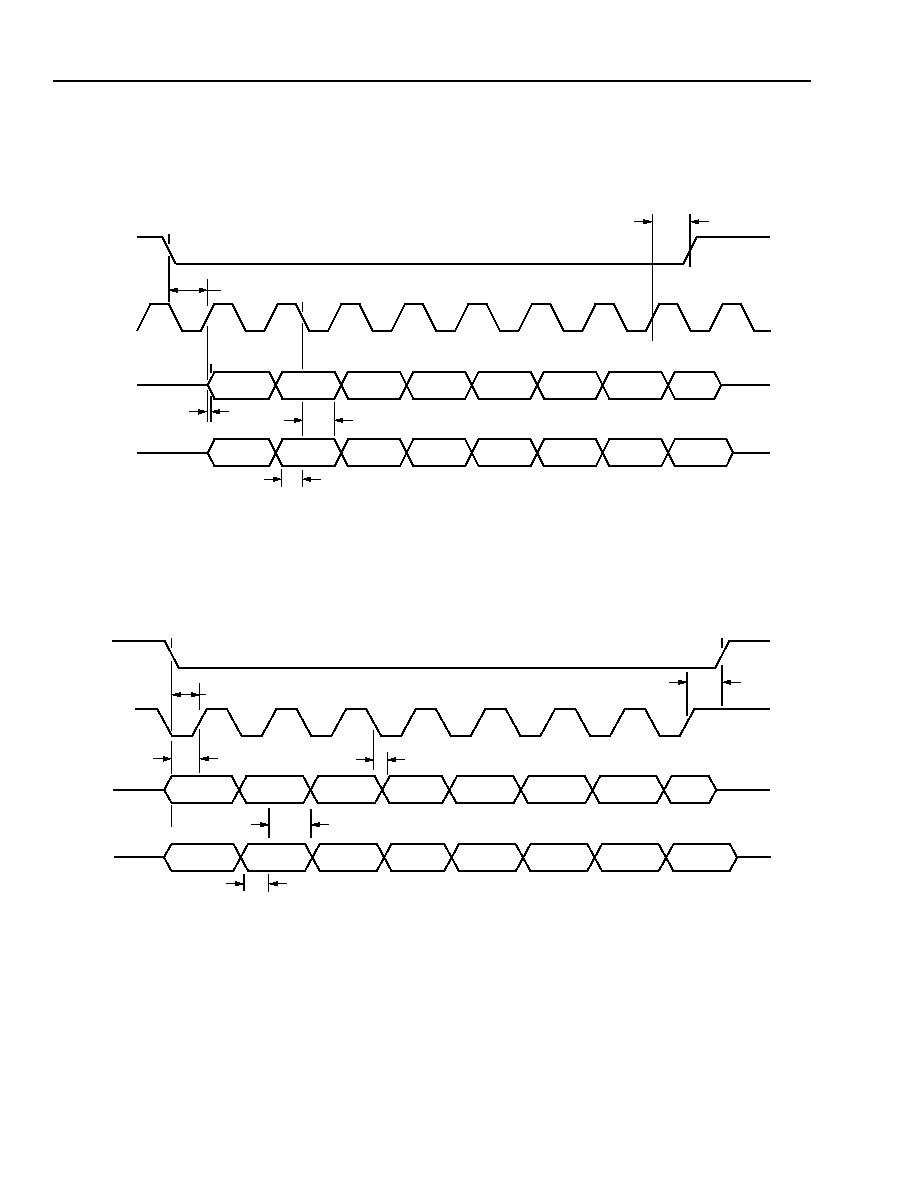
Preliminary Data Sheet
July 2001
Signal Processor
T8533/34 Quad Programmable Line Card
36
Agere Systems Inc.
Bus Timing Diagrams
Normal Mode
5-7185.MOD(F)
Figure 21. Serial Interface Timing, Normal Mode (One Byte Transfer Shown)
Byte-by-Byte Mode
5-7186e (F)
Figure 22. Serial Interface Timing, Byte-by-Byte Mode (One Byte Transfer and Gapped DCLK Shown)
1
2
3
4
5
6
7
8
9
0
1
2
3
4
5
6
7
0
1
2
3
4
5
6
7
CS
DCLK
DO
DI
LSB
t
CSSETUP
t
SXDLY
t
SDHOLD
t
SDSETUP
t
CSHOLD
0
1
2
3
4
5
6
7
0
1
2
3
4
5
6
7
0
1
2
3
4
5
6
7
CS
DCLK
DO
DI
LSB
MSB
t
CSBSETUP
t
SDBSETUP
t
SXBDLY
t
CSBHOLD
t
SDBHOLD
t
SDBSETUP
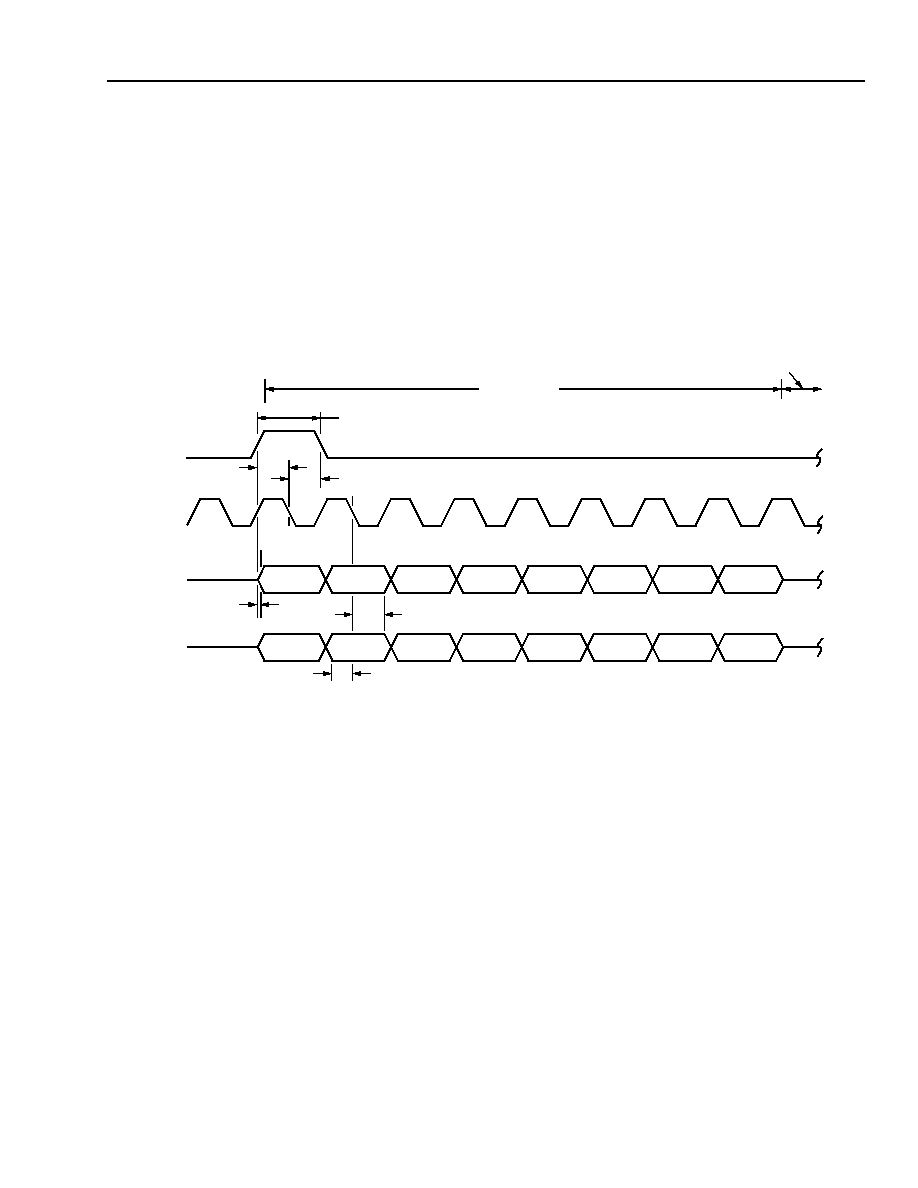
Preliminary Data Sheet
July 2001
Signal Processor
T8533/34 Quad Programmable Line Card
Agere Systems Inc.
37
Bus Timing Diagrams
(continued)
PCM Interface
Only the first time slot is shown, and the bit offset is assumed to be zero. Notice that the PCM bus transfers the
most significant bit of the time slot first, consistent with normal telephony practice. The diagram shows a bit offset
of zero from frame strobe, and for nonzero values of RXBITOFF and TXBITOFF, the relationship between FS and
DX or DR will be shifted by the programmed number of cycles of BCLK. BCLK can be any value from 256 kHz (four
time slots) to 16.384 MHz (256 time slots). The frame strobe signal is at a rate of 8 kHz and must be synchronous
with the PCM bus clock (BCLK). Sixteen-bit linear code uses two consecutive time slots with LSB transmitted/
received first. See the Clocking Considerations section for the relationship between BCLK and MCLK, if used.
5-7188.e(F)
Figure 23. PCM Bus Timing (Diagram Shown has Bit Offset of Zero and Minimum Width of FS)
1
2
3
4
5
6
7
8
9
1
2
3
4
5
6
7
8
FS
BCLK
DX
DR
LSB
1
2
3
4
5
6
7
8
TIME SLOT 0
SIGN BIT
t
FSHOLD
t
FSSETUP
t
XDLY
t
IDHOLD
t
IDSETUP
t
FSWIDTH
ADDITIONAL
TIME SLOTS

Preliminary Data Sheet
July 2001
Signal Processor
T8533/34 Quad Programmable Line Card
38
Agere Systems Inc.
Software Interface
Table 17. Memory Mapping
With the exceptions noted, all of these memory locations may be read to determine the state of the controls con-
tained therein. In the following table, bit 0 is the LSB (transmitted first on the serial interface) and bit 7 is the most
significant bit of the byte. Unused bits in an address or multibyte address should be loaded as zero. All of the mem-
ory locations can be programmed on a per-channel basis.
Note that the entire coefficient set for a channel (or all four channels) may be loaded with one command.
* The coefficients to be entered can be obtained from the Aquarium coefficient software.
Control Name
Address
(decimal)
Number
of Bits
Used
Default
Value
Name/Description
HBALTAPS*
0--127
1024
See Table
18
Balance impedance tap coefficients.
RESCTRL
128
4
0x00
Reset address. Writing a 1 in the used positions causes a
reset as defined by the bit definition. This reset remains in
force until the bit is written as a 0.
CHACTIVE
129
1
0x00
Standby/active control.
RXBITOFF
130
3
0x00
Bit offset for receive direction.
RXOFF
131
8
(16*
channel #)
Time-slot offset for receive direction.
GRX1*
132--133
11
0x0400
Control of gain affecting receive direction gain transfer.
GRX2*
134--135
11
0x01ac
Control of gain sensitive to impedance and SLIC parameter
choices, receive direction.
NORMCTRL*
136
6
0x25
Peak and far-end speech detector control.
NESCTRL*
137
3
0x06
Near-end speech detector control.
LMSGAIN*
138
8
0xee
Adaptation control address.
TDETCTRL*
139
6
0x00
Data call control address.
CTZCTRL*
140--143
31
0x07ed0000 CTZ bleed coefficients.
LMSCTRL*
144
3
0x01
Adaptation leak values.
RECCTRL*
145
5
0x00
Residual echo control.
SDCTRL*
146
7
0x19
RTZ, transmit analog gain (XAG), and analog loopback
controls.
SDTSI
147
7
(17*
channel #)
Internal time-slot interchanger. Default sets external pins to
state referenced in this data sheet.
GTX2*
148--149
12
0x0400
Control of gain affecting transmit direction gain transfer.
ZEQCTRL*
150--152
21
0x000000
Coefficients for the equalization stage that accommodates
current-sensing SLICs.
GTX1*
153--154
12
0x051a
Control of gain sensitive to impedance and SLIC parameter
choices, transmit direction.
TXBITOFF
155
3
0x00
Bit offset for transmit direction.
TXOFF
156
8
(16*
channel #)
Time-slot offset for transmit direction.
PCMCTRL
157
7
0x00
PCM control address.
SLICTS
158
6
0x0c
SLIC 3-state control address. A 1 enables the correspond-
ing SLIC pin to operate as an output pin.

Preliminary Data Sheet
July 2001
Signal Processor
T8533/34 Quad Programmable Line Card
Agere Systems Inc.
39
Software Interface
(continued)
Table 17. Memory Mapping (continued)
Table 18. Control Bit Definition
The following table shows the control bit assignments in the memory control addresses. In all control bit cases, the
bit being set places the function into the active mode as defined in the function column.
Control Name
Address
(decimal)
Number
of Bits
Used
Default
Value
Name/Description
SLICWR
159
6
0x00
Data to be written to the SLIC latches if the corresponding
bit is set in the SLICTS control word.
SLICRD
160
6
--
Current actual state of the SLIC pins. This will be the same
as SLICWR for those pins configured as outputs. All other
positions will reflect the actual state of the external pin. A
write operation to this word will be ignored, and within one
PCM frame (125
µ
s), the data will be overwritten.
VERIFY
162
8
--
Test address for serial interface verification.
DATACALL
167
1
--
Read-only indicator of a data call in progress. Do not write
this register.
--
254--255
16
--
Factory test only, do not access.
Control Name
(Address, Decimal)
[Address, Hex]
Bit
Assignment(s)
Function
HBALTAPS
(0--127)
[0x00--0x7f]
0--1023
Balance impedance coefficients. Default value is 0x00 for all bytes except
for addresses 3 and 5, which are 0x80, and address 69, which is 0x88.
RESCTRL
(128)
[0x80]
4--7
Not used, load as 0s.
3
A one resets the state associated with special data call processing.
2
A one resets the echo canceller coefficients to 0 when channel is active.
1
A one resets all other internal states. Does not affect programmed regis-
ters.
0
Reset all control addresses to default values. Note that setting this bit will
result in it and all others of this word becoming cleared on the next PCM
frame as a normal part of this control reset functionality. Also, the state
reset bits (1--3) are cleared before they are acted upon if this bit is
raised; hence, it is not possible to reset both state and control by writing
0x0F to RESCTRL. If such an action is desired, it is necessary to first
reset control by writing 0x01 and then, in a subsequent frame, write first
0x0E and then 0x00. Alternatively, hardware reset can be used to reset all
control and state.
It is necessary to wait at least 256
µ
s after asserting this bit before initiat-
ing any other serial I/O transactions.
CHACTIVE
(129)
[0x81]
1--7
Load as 0s.
0
Active/Standby mode. A 0 causes the channel to enter standby (low
power) mode and disables the PCM interface for this channel. A 1 acti-
vates the channel and the corresponding PCM bus interface. Default is 0.
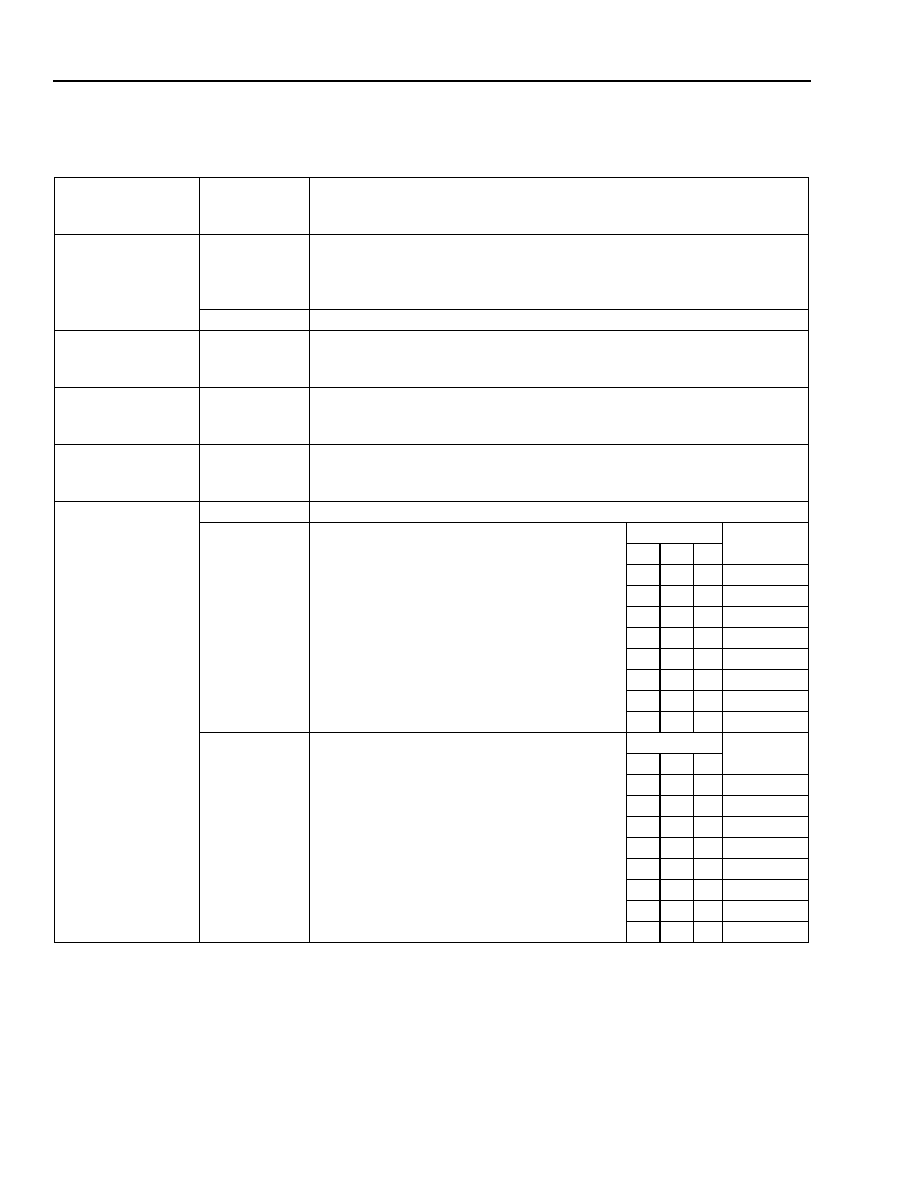
Preliminary Data Sheet
July 2001
Signal Processor
T8533/34 Quad Programmable Line Card
40
Agere Systems Inc.
Software Interface
(continued)
Table 18. Control Bit Definitions (continued)
Control Name
(Address, Decimal)
[Address, Hex]
Bit
Assignments
Function
RXBITOFF
(130)
[0x82]
5--7
Receive direction bit offset for the FS signal. Defaults to 0. These 3 bits
can be thought of as the least significant bits (RXOFF contains the more
significant bits) of a bit counter that determines the location of the first bit
of the PCM data from FS.
0--4
Load as 0.
RXOFF
(131)
[0x83]
0--7
Receive time-slot assignment. Defaults to (16 * channel number). Each
time slot represents 8 bits, allow for two time slots when using linear
mode.
GRX1
(132--133)
[0x84--0x85]
0--10
Gain adjustment for gain transfer stage in receive direction. Defaults to
0x0400 (0 dB). This is an 11-bit multiply operation with a maximum gain of
2 (6 dB). 0 dB is the maximum recommended setting.
GRX2
(134--135)
[0x86--0x87]
0--10
Gain adjustment for tweak gain stage in receive direction. Defaults to
0x01ac (
-
7.58 dB). This is an 11-bit multiply operation with a maximum
gain of 2 (6 dB). 0 dB is the maximum recommended setting.
NORMCTRL
(136)
[0x88]
6--7
Load as 0s.
3--5
Peak detector tweaking control. Use default
of 4.
Bit Number
Function
(dB)
5
4
3
0
0
0
0.0
0
0
1
-
3.01
0
1
0
-
6.02
0
1
1
-
9.03
1
0
0
-
12.04
1
0
1
-
15.05
1
1
0
-
18.06
1
1
1
-
21.07
0--2
Far-end speech detector threshold. Use
default of 5.
Bit Number
Function
(dBm0)
2
1
0
0
0
0
-
57
0
0
1
-
54
0
1
0
-
51
0
1
1
-
48
1
0
0
-
45
1
0
1
-
42
1
1
0
-
39
1
1
1
-
36

Preliminary Data Sheet
July 2001
Signal Processor
T8533/34 Quad Programmable Line Card
Agere Systems Inc.
41
Software Interface
(continued)
Table 18. Control Bit Definitions (continued)
Control Name
(Address, Decimal)
[Address, Hex]
Bit
Assignments
Function
NESCTRL
(137)
[0x89]
3--7
Load as 0s.
2
Enable near-end speech detector. Defaults to 1 (active).
0--1
Threshold for the near-end speech detec-
tor. Default is 2 (
-
6 dB).
Bit
Number
Function (dB)
(Threshold =)
1
0
0
0
0.0
0
1
-
3.5
1
0
-
6.0
1
1
-
9.5
LMSGAIN
(138)
[0x8a]
6--7
Length of echo canceller (8, 16, 32, 64
taps). Defaults to 3 (64 taps).
Bit
Number
Function
7
6
0
0
8 taps
0
1
16 taps
1
0
32 taps
1
1
64 taps
3--5
Relative adaptive gain of the two IIR taps in the echo canceller. Defaults
to 5. A setting of 0 provides no adaptive loop gain.
0--2
Loop gain for adaptation algorithm.
Default is 6.
Bit Number
Function
(Gain =)
2
1
0
0
0
0
0.0078
0
0
1
0.0156
0
1
0
0.0313
0
1
1
0.0625
1
0
0
0.1250
1
0
1
0.2500
1
1
0
0.5000
1
1
1
1.000
TDETCTRL
(139)
[0x8b]
6--7
Load as 0.
5
This bit being set allows the echo canceller coefficients developed off-
line during a data call to be captured and saved for potential use during
the next data call. Default is 0 (do not capture).
4
This bit enables the echo canceller to continue to adapt during a data
call. Default is 0 (do not adapt during a data call).
3
This bit, when set, enables the use of the internal logic to determine the
proper time for the off-line adaptation during a data call. Default is 0.
2
Selects the internal set of hybrid balance network coefficients to use on
a data call. Default is 0.
1
This bit, when set to a 1, clears the H register at the start of a data call.
Default is 0.
0
This bit being set freezes the echo canceller. Default is 0.

Preliminary Data Sheet
July 2001
Signal Processor
T8533/34 Quad Programmable Line Card
42
Agere Systems Inc.
Software Interface
(continued)
Table 18. Control Bit Definitions (continued)
Control Name
(Address, Decimal)
[Address, Hex]
Bit
Assignments
Function
CTZCTRL
(140--143)
[0x8c
--0x8f]
0--30
Coefficients for the CTZ termination bleed. Defaults to 0x07ed0000.
LMSCTRL
(144)
[0x90]
3--7
Load as 0s.
0--2
Leak coefficient for LMS adaptation algorithm. Defaults to 1.
RECCTRL
(145)
[0x91]
5--7
Load as 0s.
4
Noise match enable (comfort noise). Defaults to 0 (disabled).
3
Enable residual echo control. Defaults to 0 (disabled).
0--2
Residual echo control sensitivity factor.
Defaults to 0.
Bit Number
Function
(dB)
(Threshold =)
2
1
0
0
0
0
0.0
0
0
1
-
3.5
0
1
0
-
6.0
0
1
1
-
9.5
1
0
0
-
12.0
1
0
1
-
15.5
1
1
0
-
18.0
1
1
1
-
21.6
SDCTRL
(146)
[0x92]
7
Load as 0.
6
Enable analog loopback. Defaults to 0 (no loopback).
3--5
RTZ gain. Defaults to 3 (equal level point value of 3 * 0.075 = 0.225).
0--2
Transmit analog gain (XAG). Defaults to 1
(6 dB) gain.
Bit Number
Function
(dB)
2
1
0
0
0
0
0.0
0
0
1
6.02
0
1
0
12.04
0
1
1
18.06
1
0
0
24.08
SDTSI
(147)
[0x93]
7
Load as 0.
6
Digital loopback, loopback from receive to transmit at the sigma-delta
converters (digital loopback 2). Defaults to 0 (no loopback).
4--5
Digital channel feeding this analog receive channel. Defaults to channel
number.
3
Send idle channel code (alternating bits) to this analog receive path.
Defaults to 0 (do not send idle channel code).
2
Loopback from transmit to receive at the sigma-delta converters (digital
loopback 3). Defaults to 0 (no loopback).
0--1
Analog channel feeding this digital channel in the transmit direction.
Defaults to channel number.
GTX2
(148--149)
[0x94
--0x95]
0--11
Gain control for gain transfer stage in transmit direction. Defaults to
0x0400 (0 dB). This is a 12-bit multiply operation with a maximum gain of
4 (12 dB).

Preliminary Data Sheet
July 2001
Signal Processor
T8533/34 Quad Programmable Line Card
Agere Systems Inc.
43
Software Interface
(continued)
Table 18. Control Bit Definitions (continued)
Control Name
(Address, Decimal)
[Address, Hex]
Bit
Assignments
Function
ZEQCTRL
(150--152)
[0x96--0x98]
0--20
Coefficients for the equalization stage that accommodates current-sens-
ing SLICs. Defaults to 0x000000.
GTX1
(153--154)
[0x99--0x9a]
0--11
Gain control for tweak gain stage in transmit direction. Defaults to 0x051a
(2.11 dB). This is a 12-bit multiply operation with a maximum gain of 4
(12 dB).
TXBITOFF
(155)
[0x9b]
5--7
Transmit direction bit offset for the FS signal. Defaults to 0. These 3 bits
can be thought of as the least significant bits (TXOFF contains the more
significant bits) of a bit counter that determines the location of the first bit
of the PCM data from FS.
0--4
Load as 0.
TXOFF
(156)
[0x9c]
0--7
Transmit time-slot assignment. Defaults to (16 * channel number). Each
time slot represents 8 bits, allow for two time slots when using linear
mode.
PCMCTRL
(157)
[0x9d]
7
3-state transmit PCM interface. Defaults to 0. A 1 forces the PCM inter-
face into a high-impedance state during its assigned time slot on the PCM
bus. Placing the channel in standby mode also forces a high-impedance
condition on the transmit interface.
6
Transmit zeroes instead of data. Defaults to 0 (off).
5
Load as 0.
4
Place idle channel code on receive path. Defaults to 0 (off).
3
Loopback receive to transmit at PCM conversion interface (digital loop-
back 1). Defaults to 0 (no loopback).
2
Loopback transmit to receive at PCM conversion interface (digital loop-
back 4). Defaults to 0 (no loopback).
1
Linear/companded. A 1 sets 16-bit linear mode with two adjacent time
slots used, LSB transmitted first. Linear data is in two's complement form.
A 0 sets companded mode with only one time slot used, and MSB trans-
mitted first. Defaults to 0.
0
µ
-law or A-law. A 0 sets
µ
-law mode, and a 1 sets A-law mode. This bit
has no effect if bit 1 of this address is set to 1. Defaults to 0 (
µ
-law).
SLICTS
(158)
[0x9e]
6--7
Load as 0.
0--5
Controls the drivers for the corresponding SLIC latches. A 1 enables the
pin as an output. Defaults to 0x0c (bits 2 and 3 set, the rest cleared).
SLICWR
(159)
[0x9f]
6--7
Load as 0.
0--5
SLIC data latches. If the corresponding bit in the SLICTS address is set
for an output, the device will drive the corresponding bit according to the
contents of this address. Writes are performed within 125
µ
s. Wait
125
µ
s before a subsequent write to the same channel or between write
all channel commands. Default is 0.
SLICRD
(160)
[0xa0]
6--7
Not used, ignore on a codec read command addressing this location.
0--5
Reports the actual state of the SLIC pins. Anything written to this address
is ignored. Updates within 125
µ
s.
VERIFY
(162)
[0xa2]
0--7
Test location for serial interface. This location has no internal use, but
merely latches write data for the purpose of testing the serial interface.
This register does not clear with reset.
DATACALL
(167)
[0xa7]
5
This bit is set to a 1 if a data call is in progress. Do not attempt to write this
register.
0--4, 6, 7
Internal state control bits; do not write and ignore on read.

Preliminary Data Sheet
July 2001
Signal Processor
T8533/34 Quad Programmable Line Card
44
Agere Systems Inc.
Applications
The following reference circuit shows a complete schematic for interfacing to the Agere L9215G SLIC. All ac
parameters are programmed by the T8534. Note that this implementation differentiates itself in that no external
components are required in the ac interface to provide a dc termination impedance or for stability. For illustration
purposes, 0.5 Vrms PPM injection was assumed in this example and no meter pulse rejection is used. Also, this
example illustrates the device using programmable overhead and current limit.
12-3534.z (F)
*R
VFxI
is required for complex terminations. Optional for resistive terminations.
Figure 24. POTS Interface
V
BAT1
BGND
V
BAT2
V
CC
AGND
ICM
TRGDET
ground key
not used
C
BAT1
0.1
µ
F
C
BAT2
0.1
µ
F
C
CC
0.1
µ
F
RTFLT
DCOUT
PR
PT
OVH
V
PROG
V
REF
C
RT
0.1
µ
F
R
RT
383
k
AGERE
L7591
V
BAT1
FUSIBLE OR PTC
50
50
CF1
CF2
rate of battery
reversal not
ramped
FB1 FB2 NSTAT BR
B2 B1 B0
C
F1
0.22
µ
F
C
F2
0.1
µ
F
PPM
0.5 Vrms
C
PPM
10 nF
RING
IN
PPM
IN
VITR
RCVP
RCVN
ITR
VTX
TXI
R
GX
4750
V
BAT1
D
BAT1
V
BAT2
V
CC
C
TX
0.1
µ
F
C
RING
0.47
µ
F
FROM
PROGRAMMABLE
D/A VOLTAGE
SOURCE
C
C1
PCM
HIGHWAY
DX0
DR0
DX1
DR1
FS
BCLK
DGND
V
DD
SYNC
AND
V
DD
VFXI
VFROP
VFRON
SLIC4a
SLIC3a
SLIC2a
SLIC1a
SLIC0a
CLOCK
L9215G
FROM/TO
CONTROL
B2
B1
BR
NSTAT
B0
0.1
µ
F
FUSIBLE OR PTC
T8534
R
PD
1
10
k
R
VFxI
*
20 M
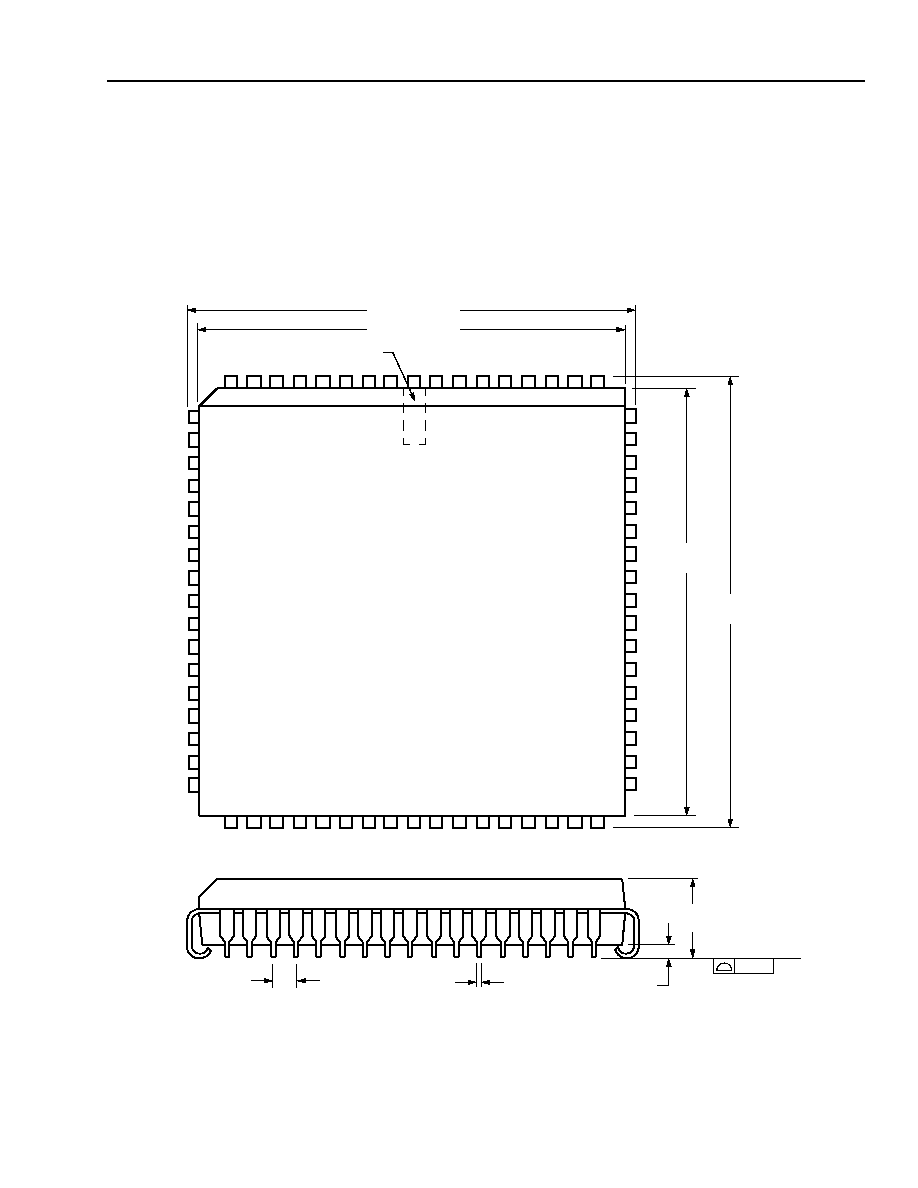
Preliminary Data Sheet
July 2001
Signal Processor
T8533/34 Quad Programmable Line Card
Agere Systems Inc.
45
Outline Diagrams
68-Pin PLCC
Dimensions are in millimeters.
Note: The dimensions in this outline diagram are intended for informational purposes only.
For detailed footprint drawings to assist your design efforts, please contact your Agere Sales Representa-
tive.
5-2139(F)
1
9
10
26
27
43
44
60
61
PIN #1 IDENTIFIER ZONE
25.146
±
0.127
24.231
±
0.102
25.146
±
0.127
24.231
±
0.102
1.27 TYP
0.330/0.533
5.080
MAX
0.51 MIN,
TYP
SEATING PLANE
0.10
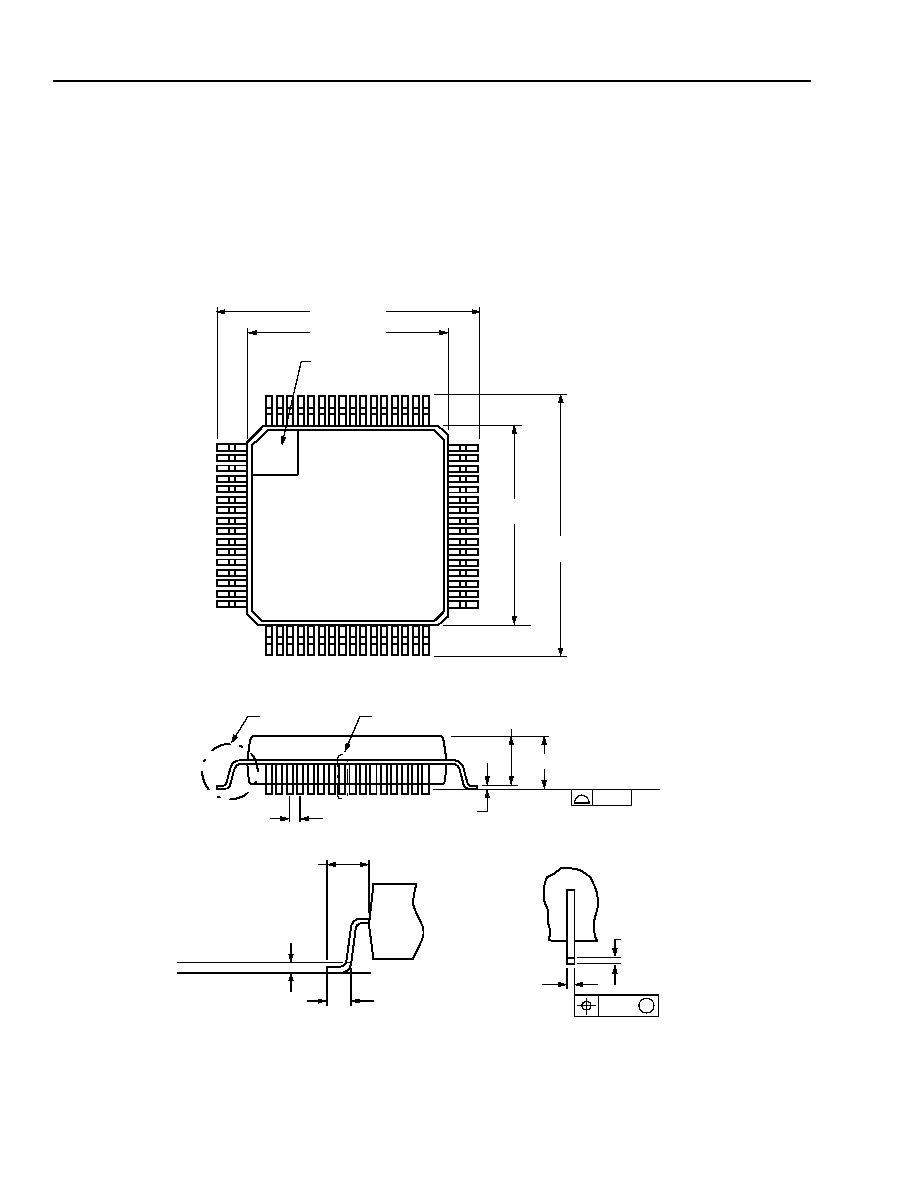
Preliminary Data Sheet
July 2001
Signal Processor
T8533/34 Quad Programmable Line Card
46
Agere Systems Inc.
Outline Diagrams
(continued)
64-Pin TQFP
Dimensions are in millimeters.
Note: The dimensions in this outline diagram are intended for informational purposes only.
For detailed footprint drawings to assist your design efforts, please contact your Agere Sales Representa-
tive.
5-3080(F)
DETAIL A
0.50 TYP
1.60 MAX
SEATING PLANE
0.08
DETAIL B
0.05/0.15
1.40
±
0.05
10.00
±
0.20
12.00
±
0.20
1
64
49
16
17
32
48
33
10.00
±
0.20
12.00
±
0.20
PIN #1
IDENTIFIER ZONE
DETAIL A
0.45/0.75
GAGE PLANE
SEATING PLANE
1.00 REF
0.25
DETAIL B
0.19/0.27
0.08
M
0.106/0.200
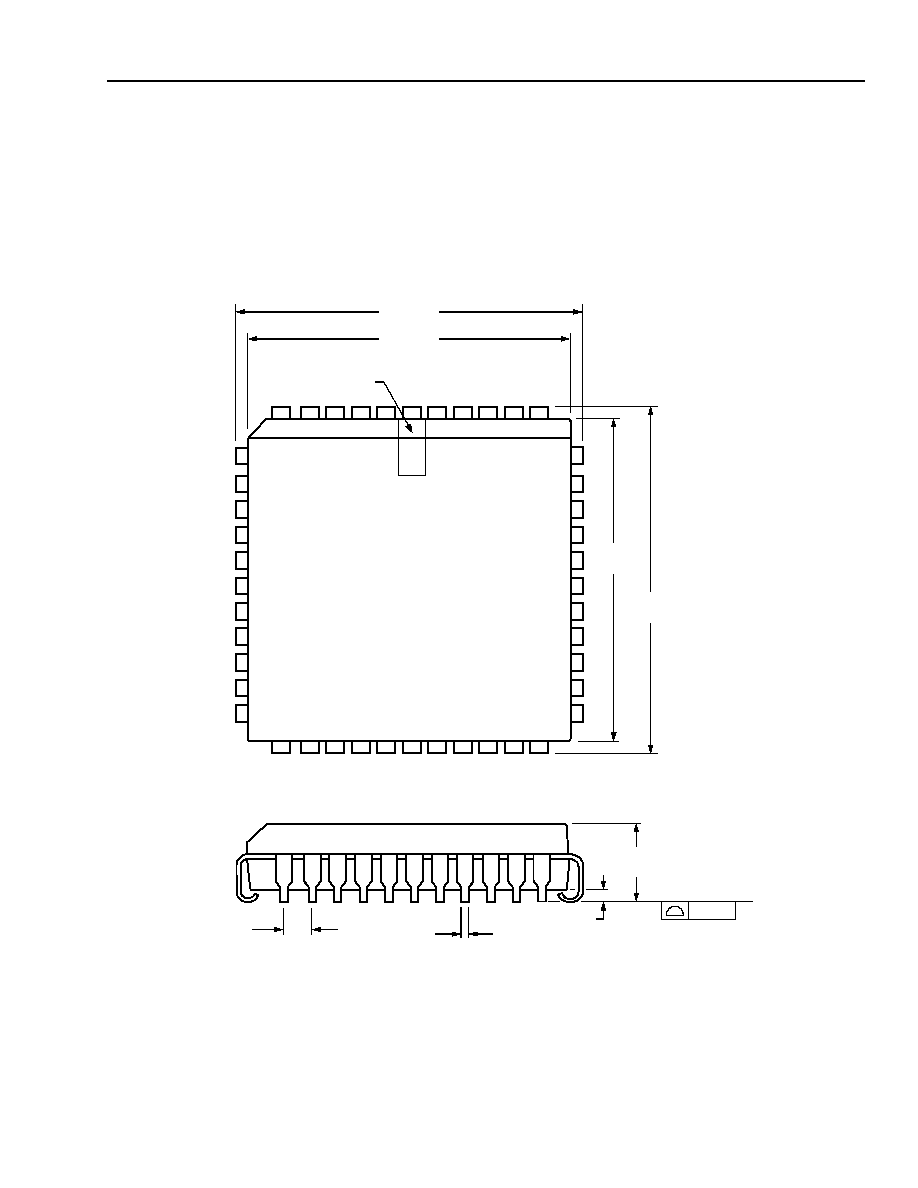
Preliminary Data Sheet
July 2001
Signal Processor
T8533/34 Quad Programmable Line Card
Agere Systems Inc.
47
Outline Diagrams
(continued)
44-Pin PLCC
Dimensions are in millimeters.
Note: The dimensions in this outline diagram are intended for informational purposes only.
For detailed footprint drawings to assist your design efforts, please contact your Agere Sales Representa-
tive.
5-2506(F)
4.57
MAX
1.27 TYP
0.53
MAX
0.10
SEATING PLANE
0.51 MIN
TYP
1
6
40
7
17
29
39
18
28
PIN #1 IDENTIFIER
ZONE
16.66 MAX
17.65 MAX
16.66
MAX
17.65
MAX

Preliminary Data Sheet
July 2001
Signal Processor
T8533/34 Quad Programmable Line Card
Agere Systems Inc. reserves the right to make changes to the product(s) or information contained herein without notice. No liability is assumed as a result of their use or application.
Copyright © 2001 Agere Systems Inc.
All Rights Reserved
July 2001
DS01-250ALC (Replaces DS01-058ALC)
For additional information, contact your Agere Systems Account Manager or the following:
INTERNET: http://www.agere.com
E-MAIL: docmaster@micro.lucent.com
N. AMERICA:
Agere Systems Inc., 555 Union Boulevard, Room 30L-15P-BA, Allentown, PA 18109-3286
1-800-372-2447, FAX 610-712-4106 (In CANADA: 1-800-553-2448, FAX 610-712-4106)
ASIA PACIFIC: Agere Systems Singapore Pte. Ltd., 77 Science Park Drive, #03-18 Cintech III, Singapore 118256
Tel. (65) 778 8833, FAX (65) 777 7495
CHINA: Agere Systems (Shanghai) Co., Ltd., 33/F Jin Mao Tower, 88 Century Boulevard Pudong, Shanghai 200121 PRC
Tel. (86) 21 50471212, FAX (86) 21 50472266
JAPAN: Agere Systems Japan Ltd., 7-18, Higashi-Gotanda 2-chome, Shinagawa-ku, Tokyo 141, Japan
Tel. (81) 3 5421 1600, FAX (81) 3 5421 1700
EUROPE: Data Requests: DATALINE: Tel. (44) 7000 582 368, FAX (44) 1189 328 148
Technical Inquiries: GERMANY: (49) 89 95086 0 (Munich), UNITED KINGDOM: (44) 1344 865 900 (Ascot),
FRANCE: (33) 1 40 83 68 00 (Paris), SWEDEN: (46) 8 594 607 00 (Stockholm), FINLAND: (358) 9 3507670 (Helsinki),
ITALY: (39) 02 6608131 (Milan), SPAIN: (34) 1 807 1441 (Madrid)
Ordering Information
Device Code Package Comcode
T-8533 - - - ML - D 44-Pin PLCC, Dry-bagged 108269408
T-8534 - - - TL - DB 64-Pin TQFP, Dry pack tray 108420217
T-8534 - - - ML - D 68-Pin PLCC, Dry-bagged 108269424















































